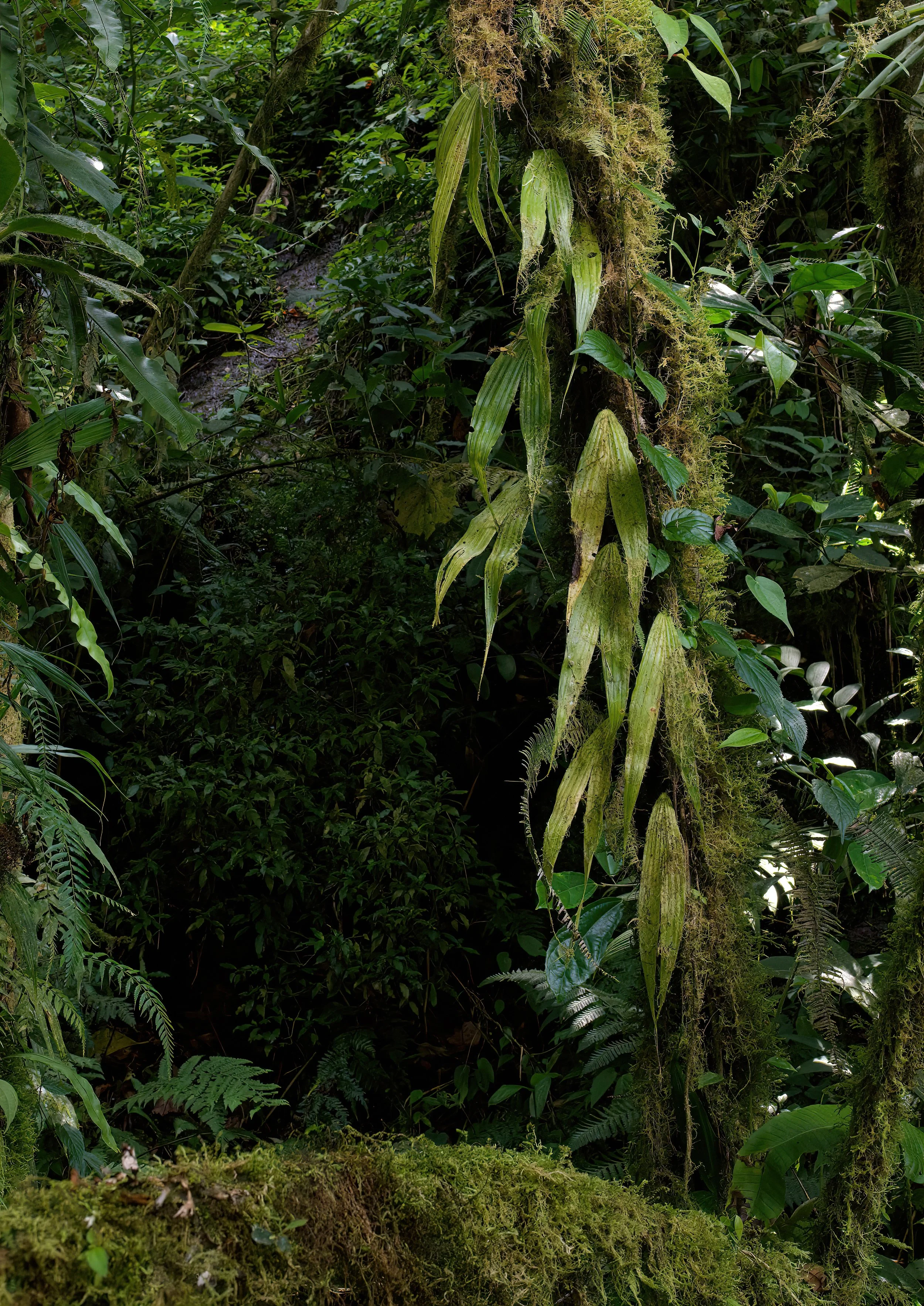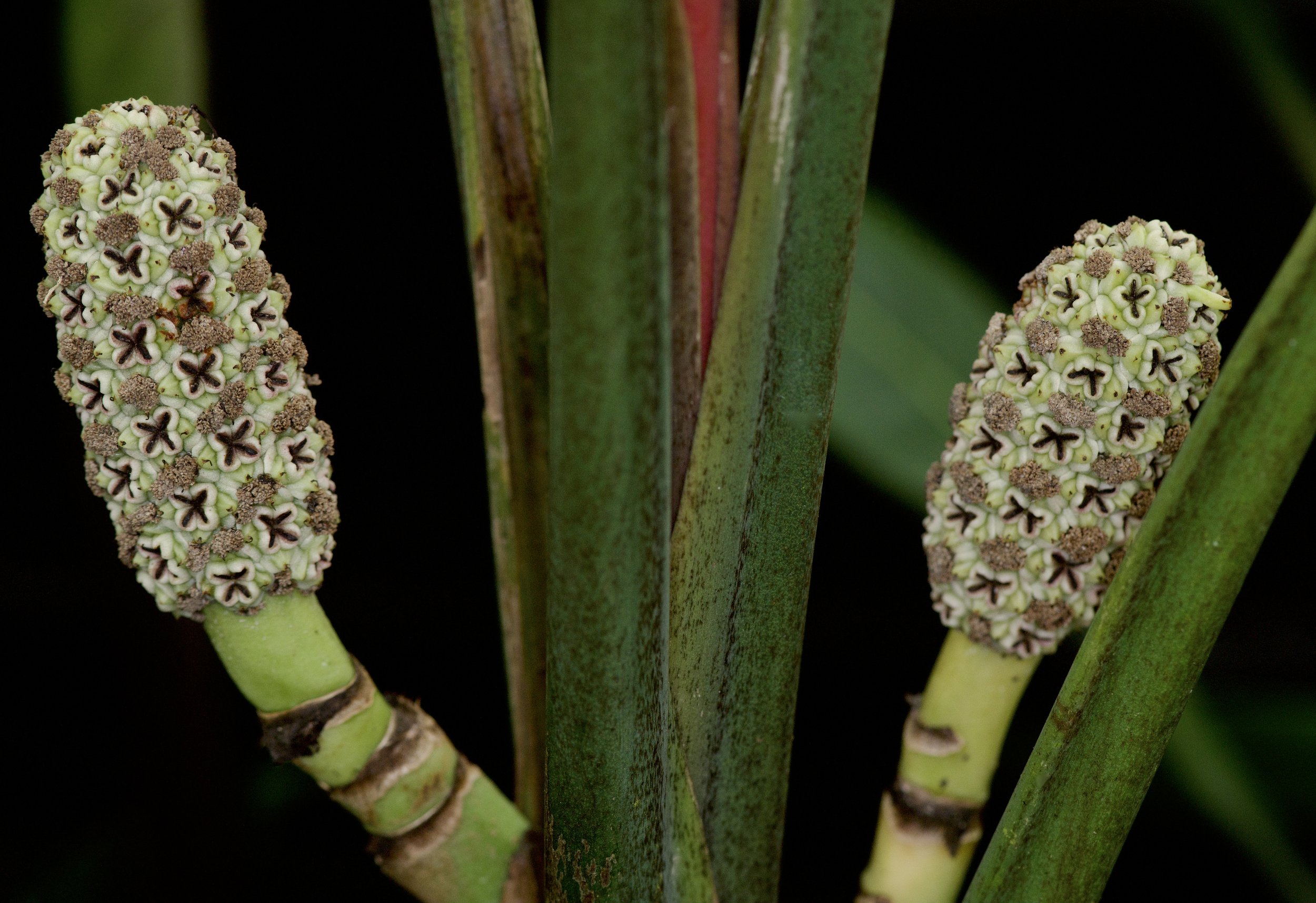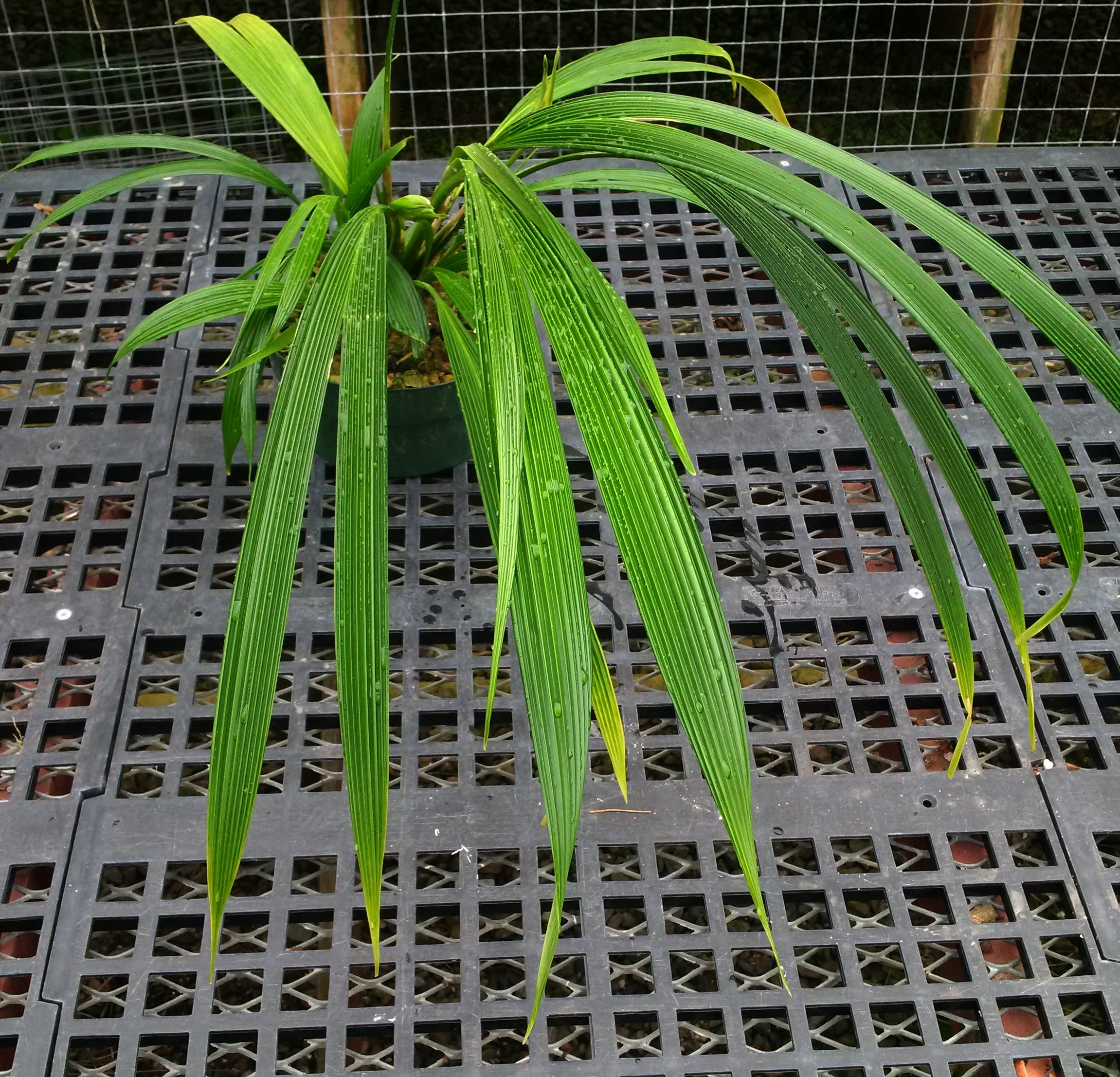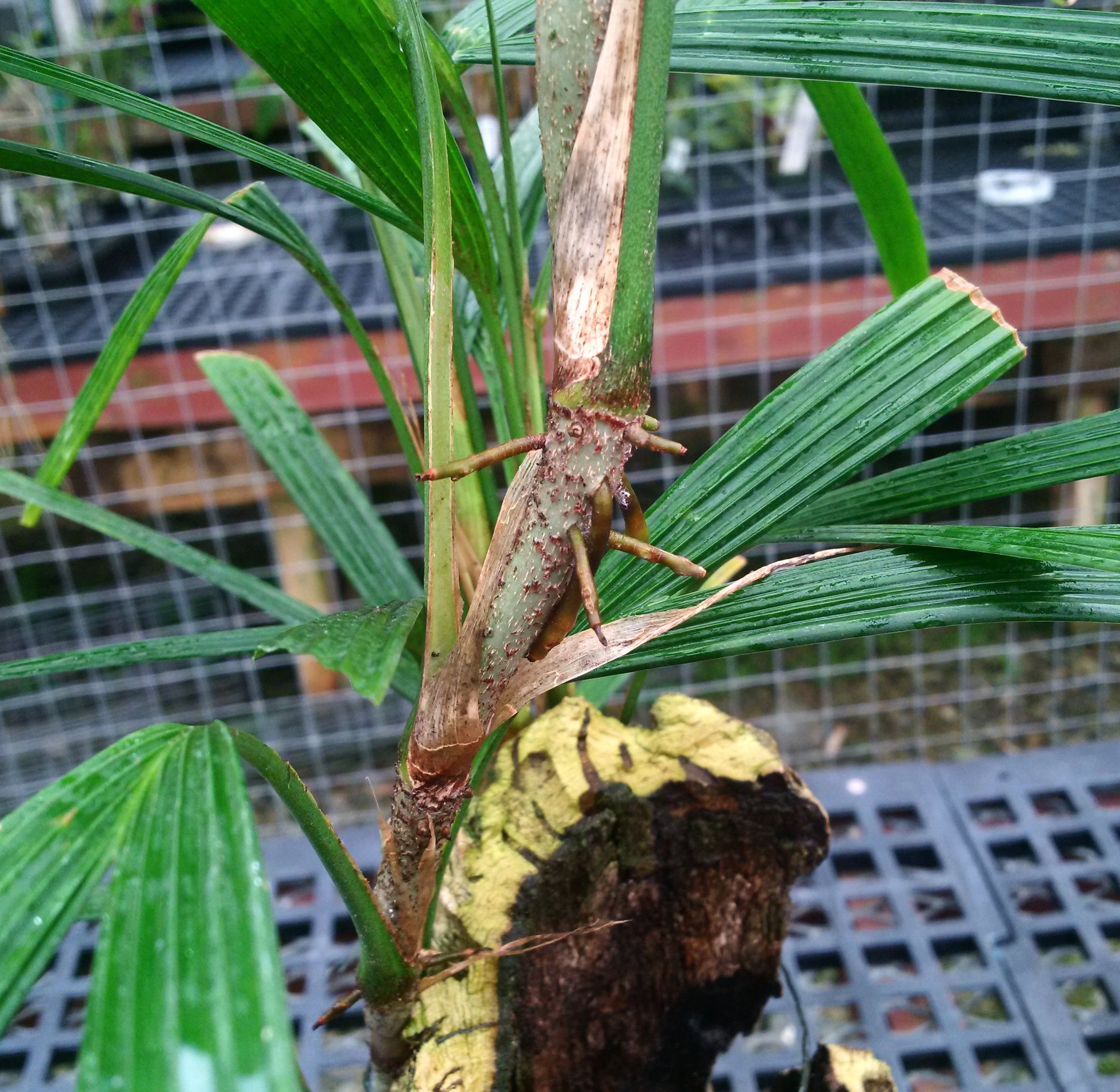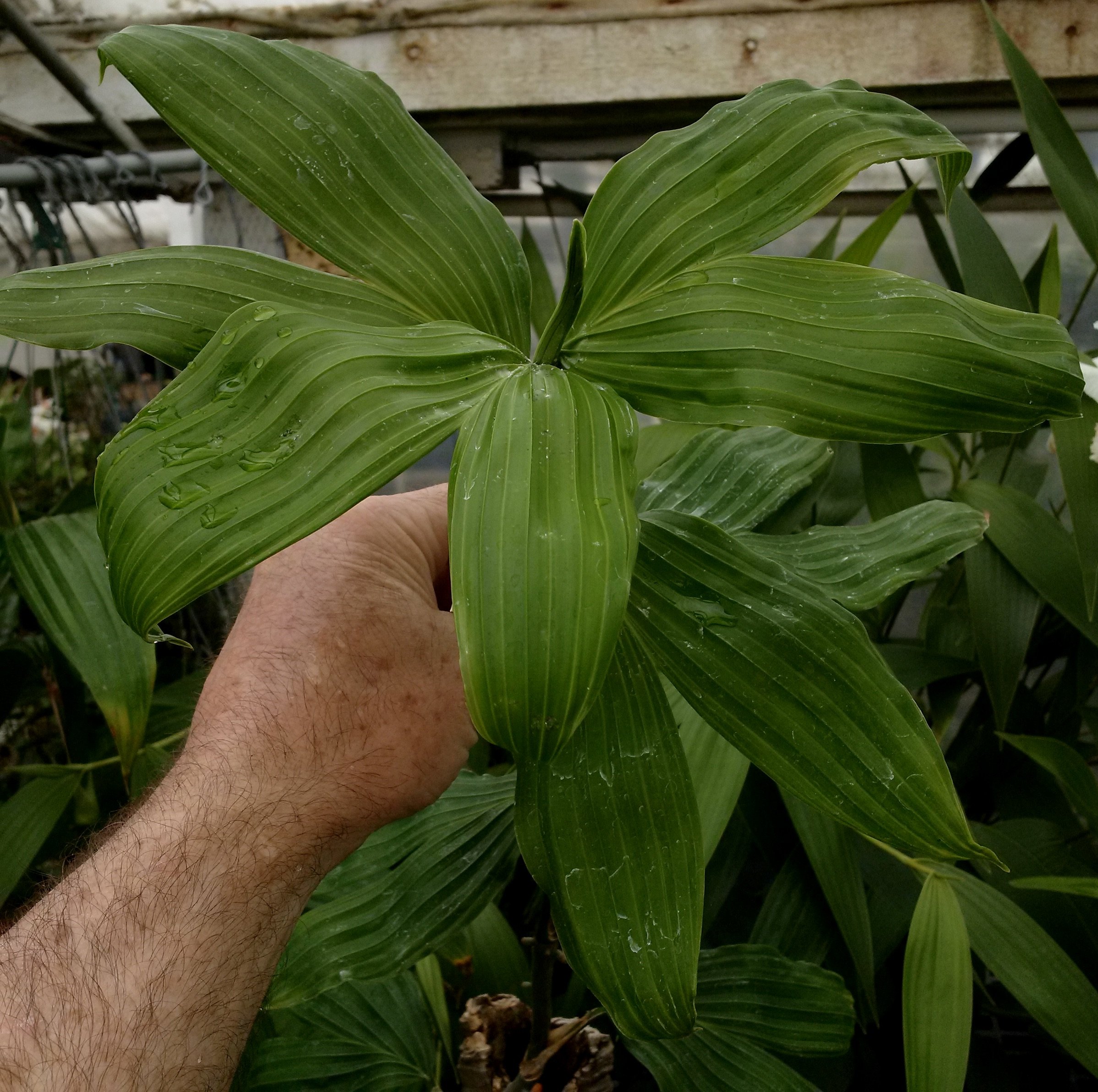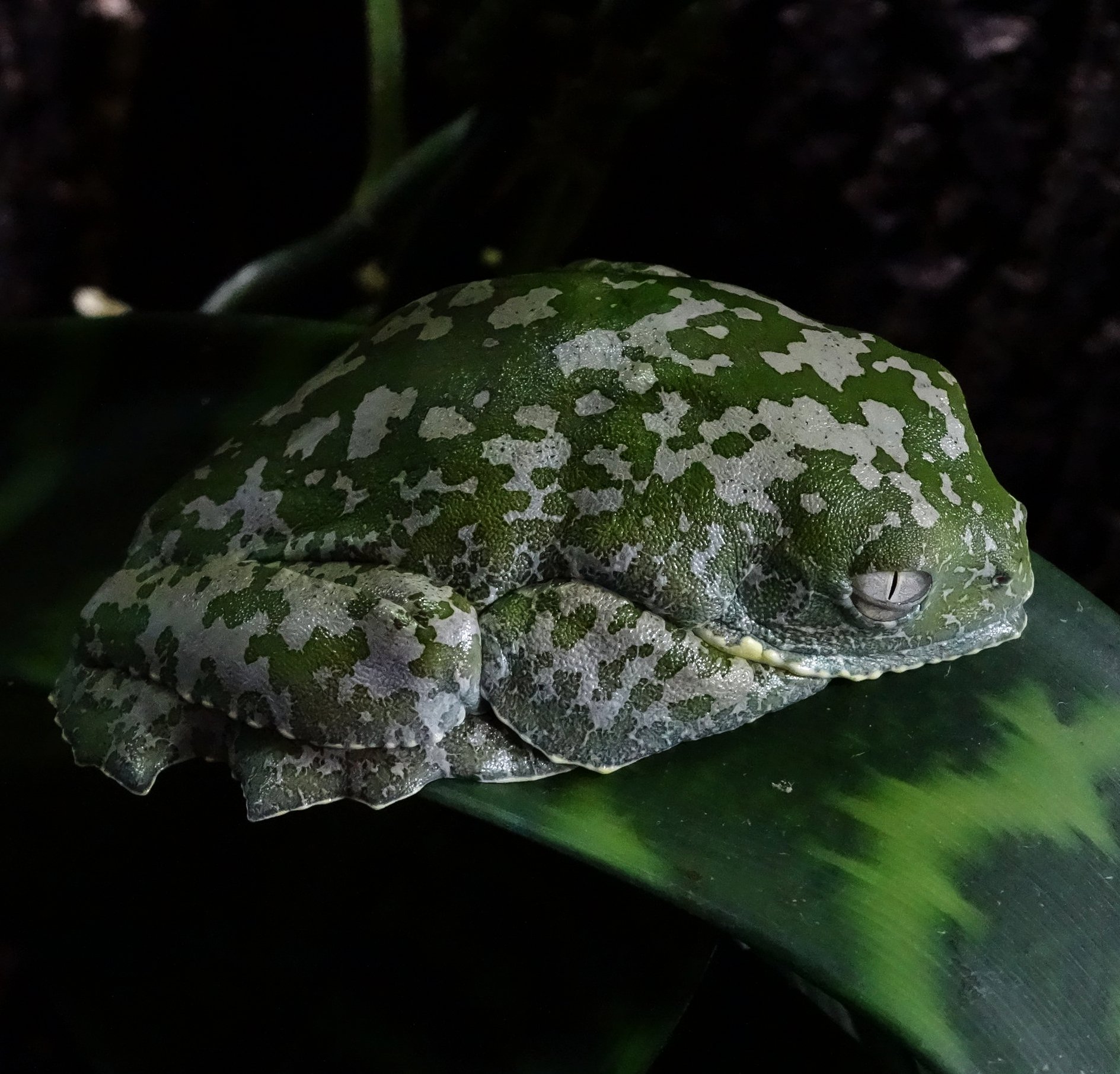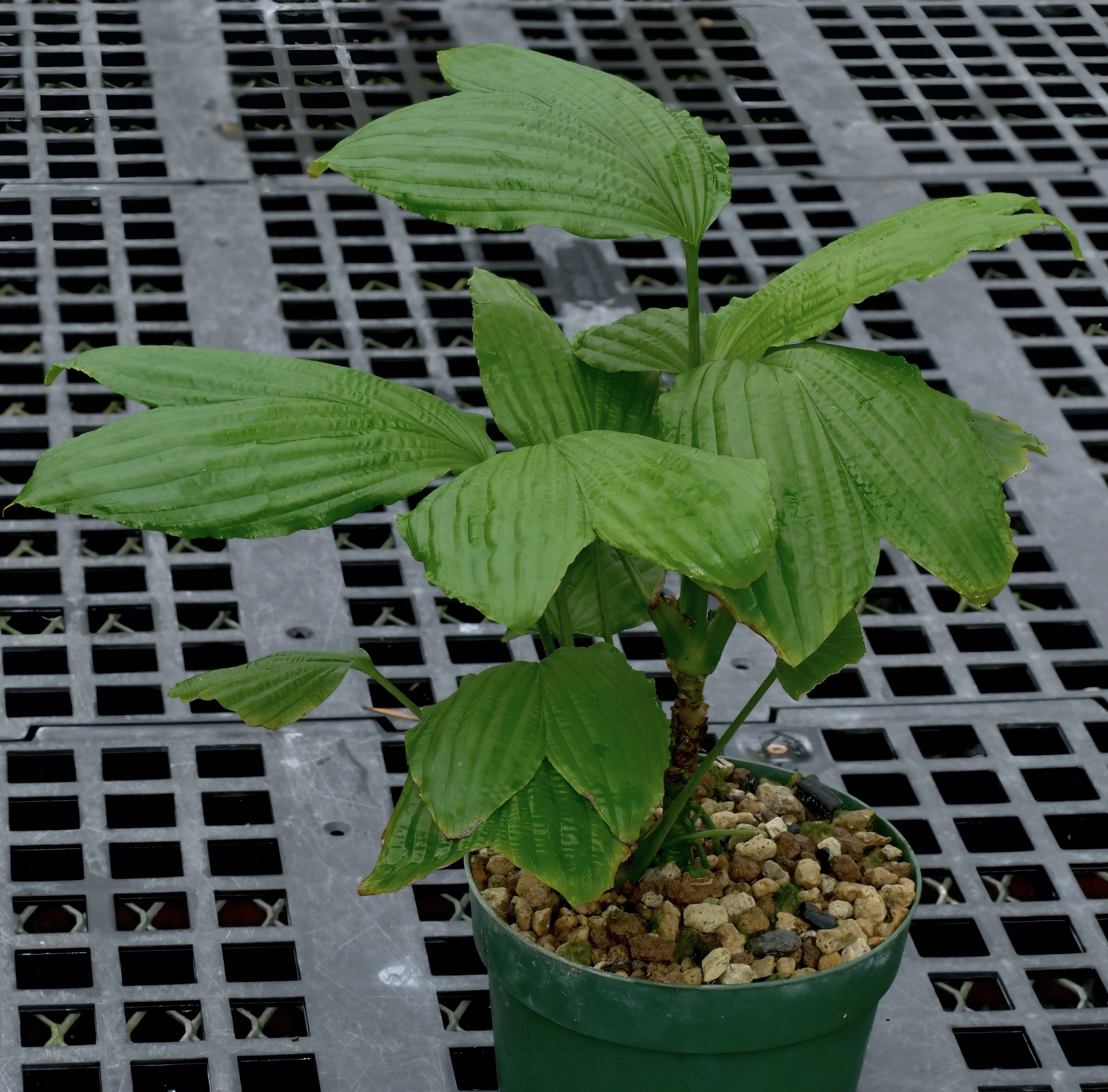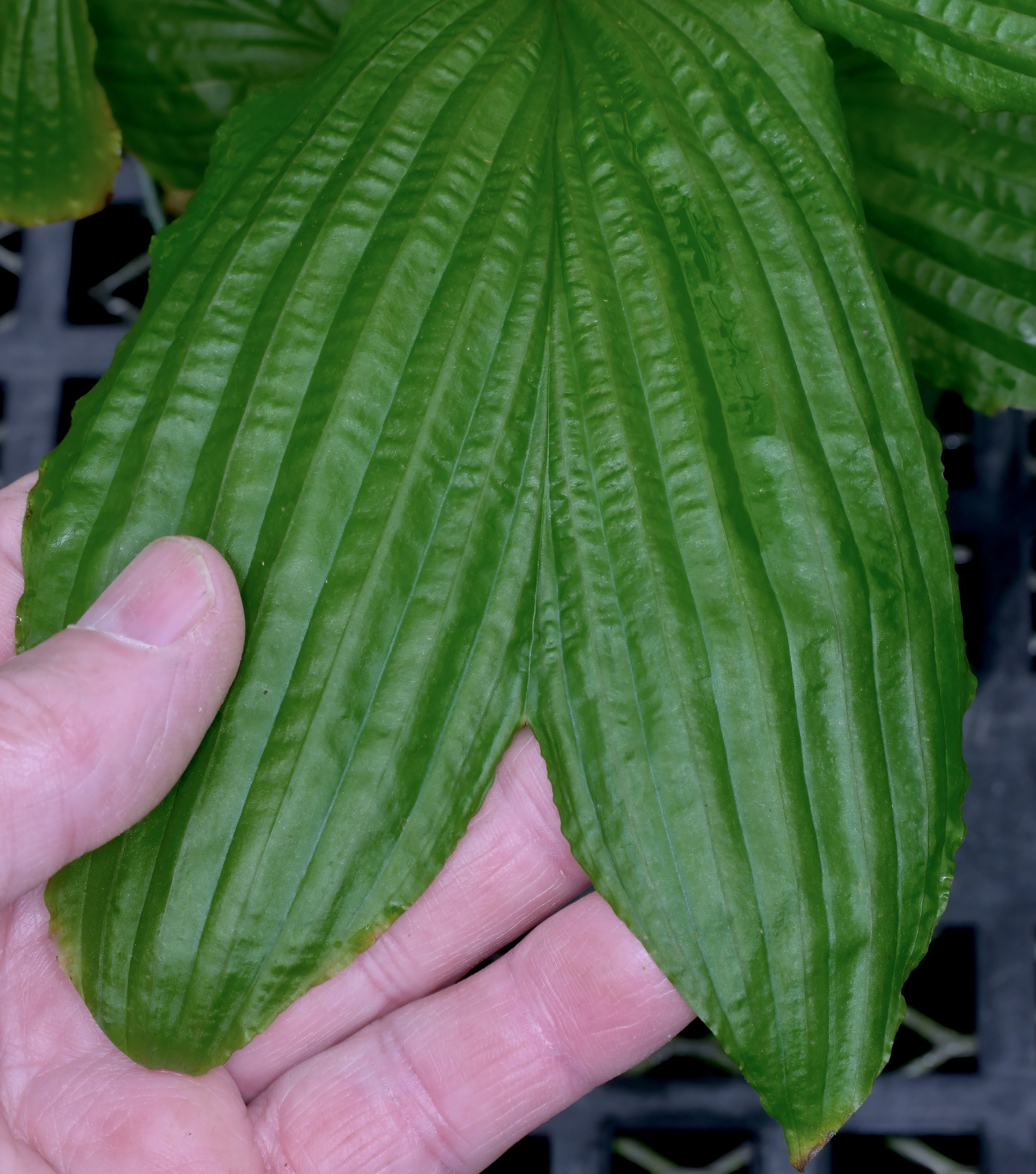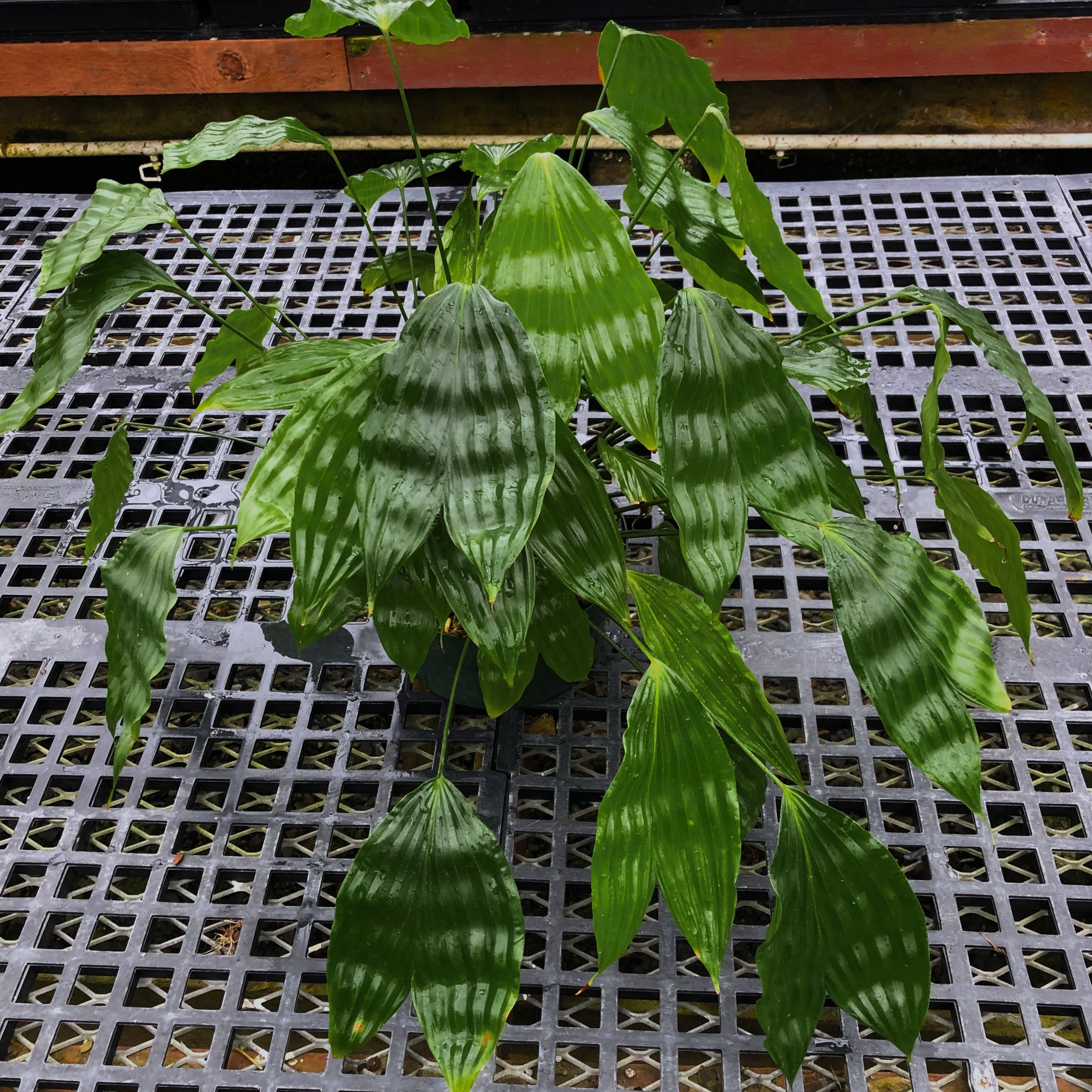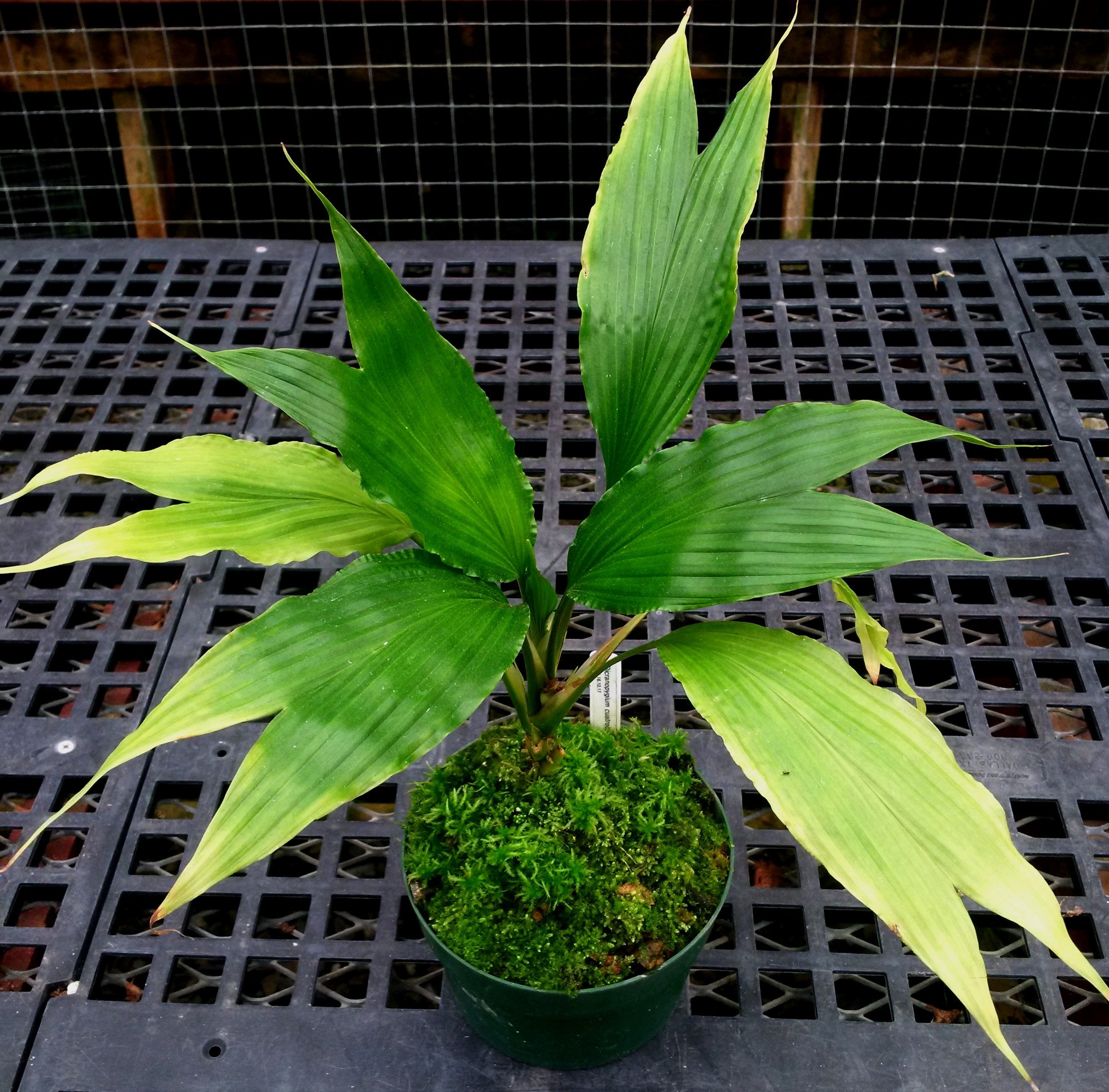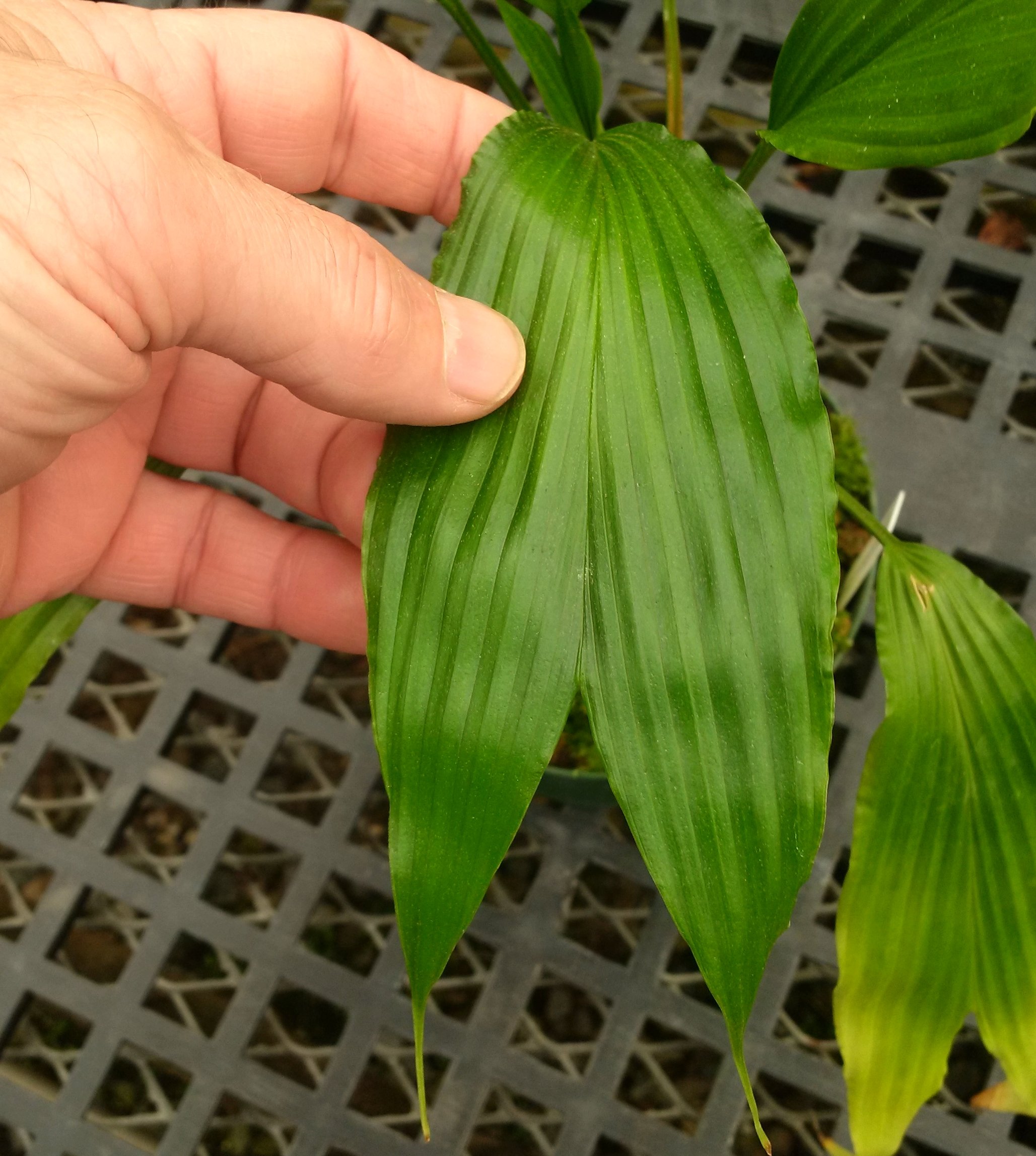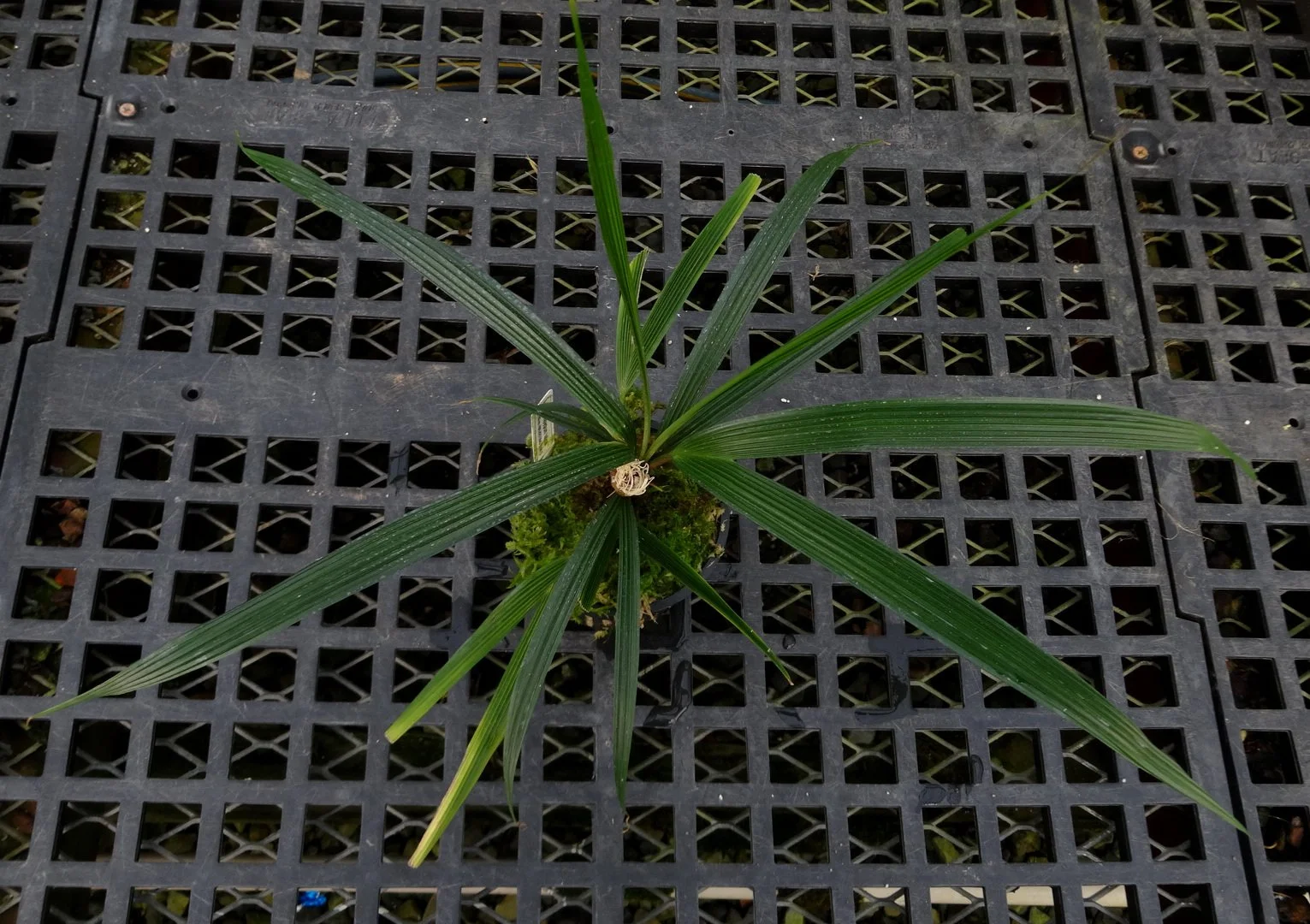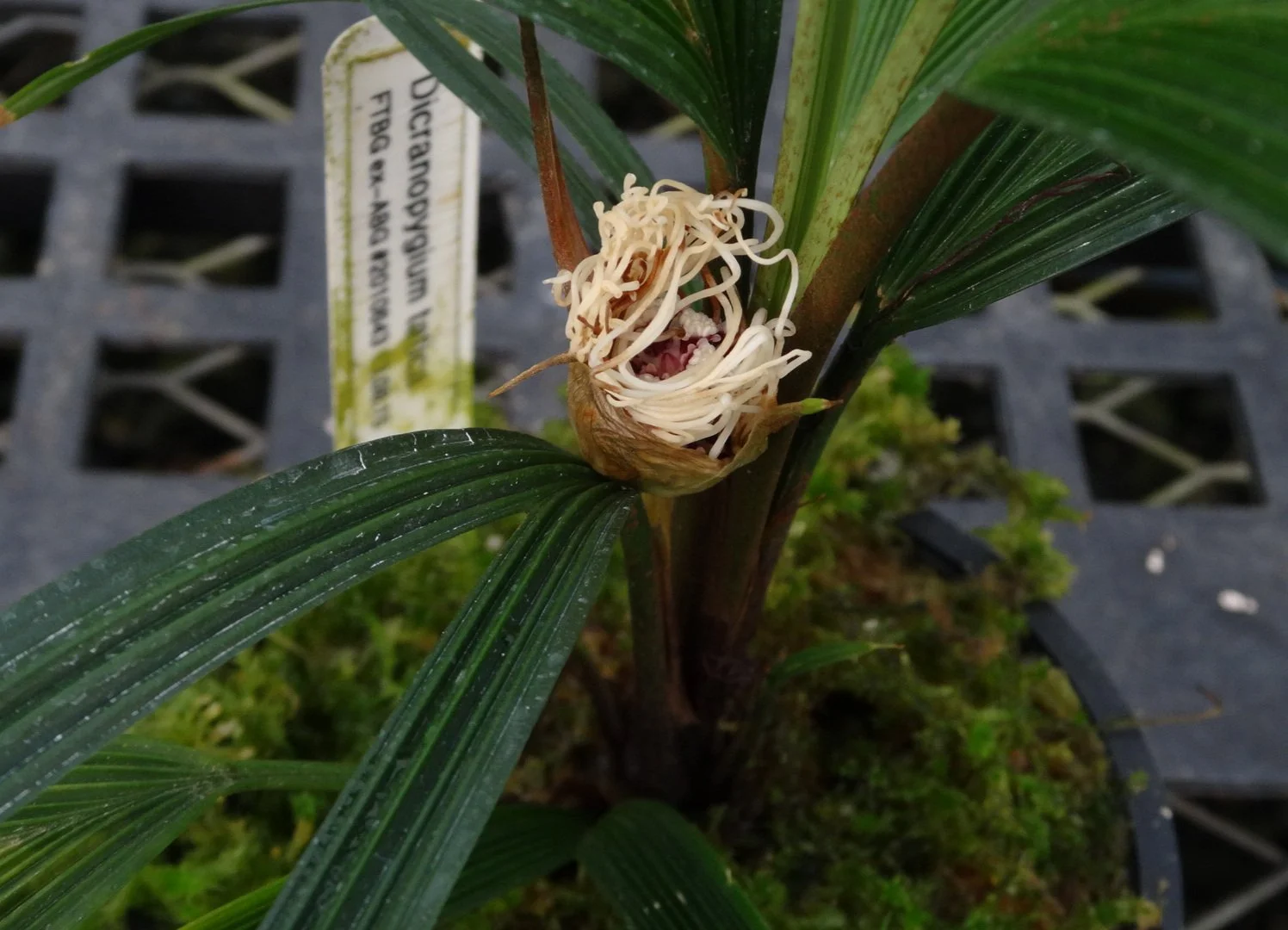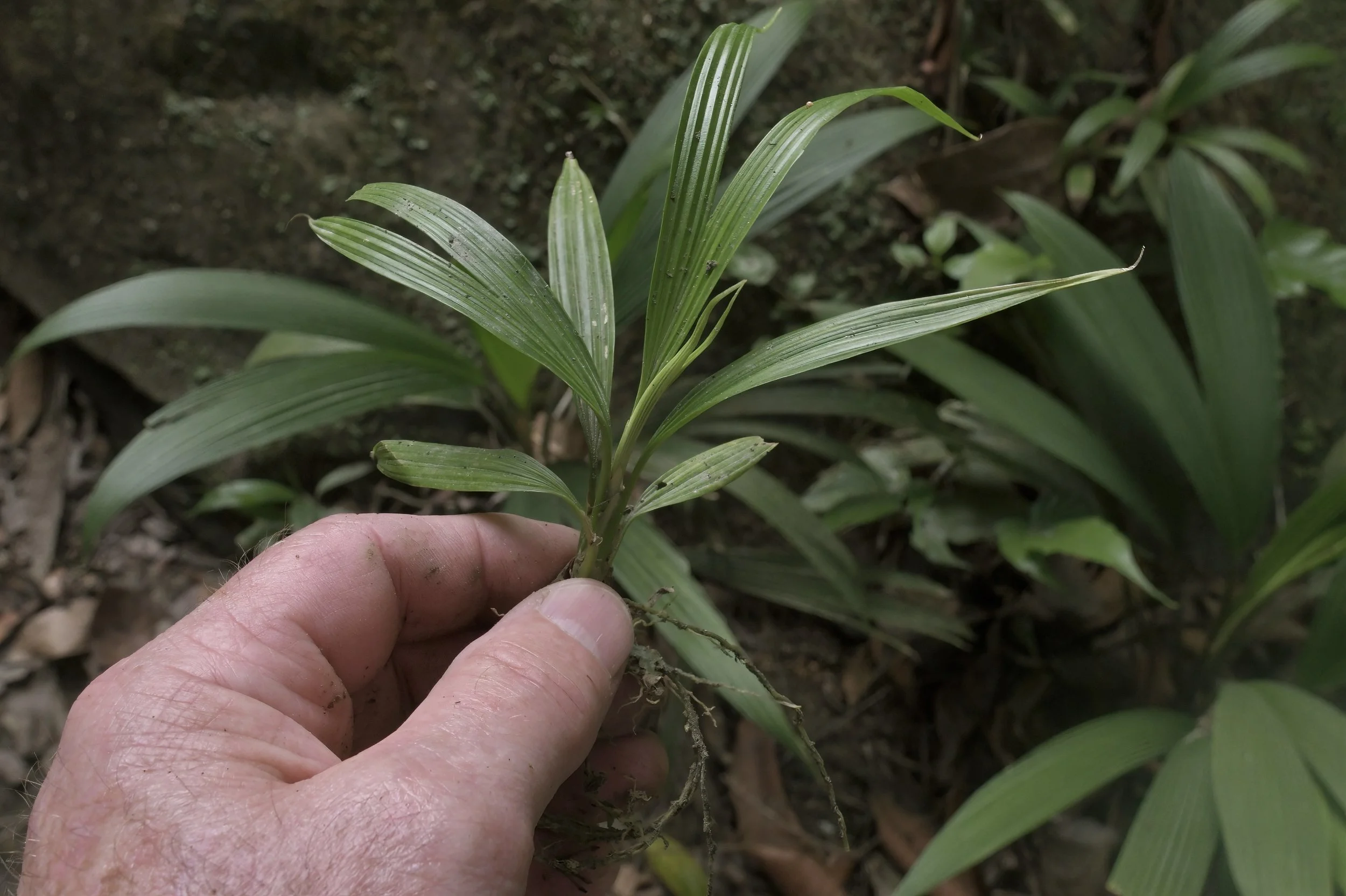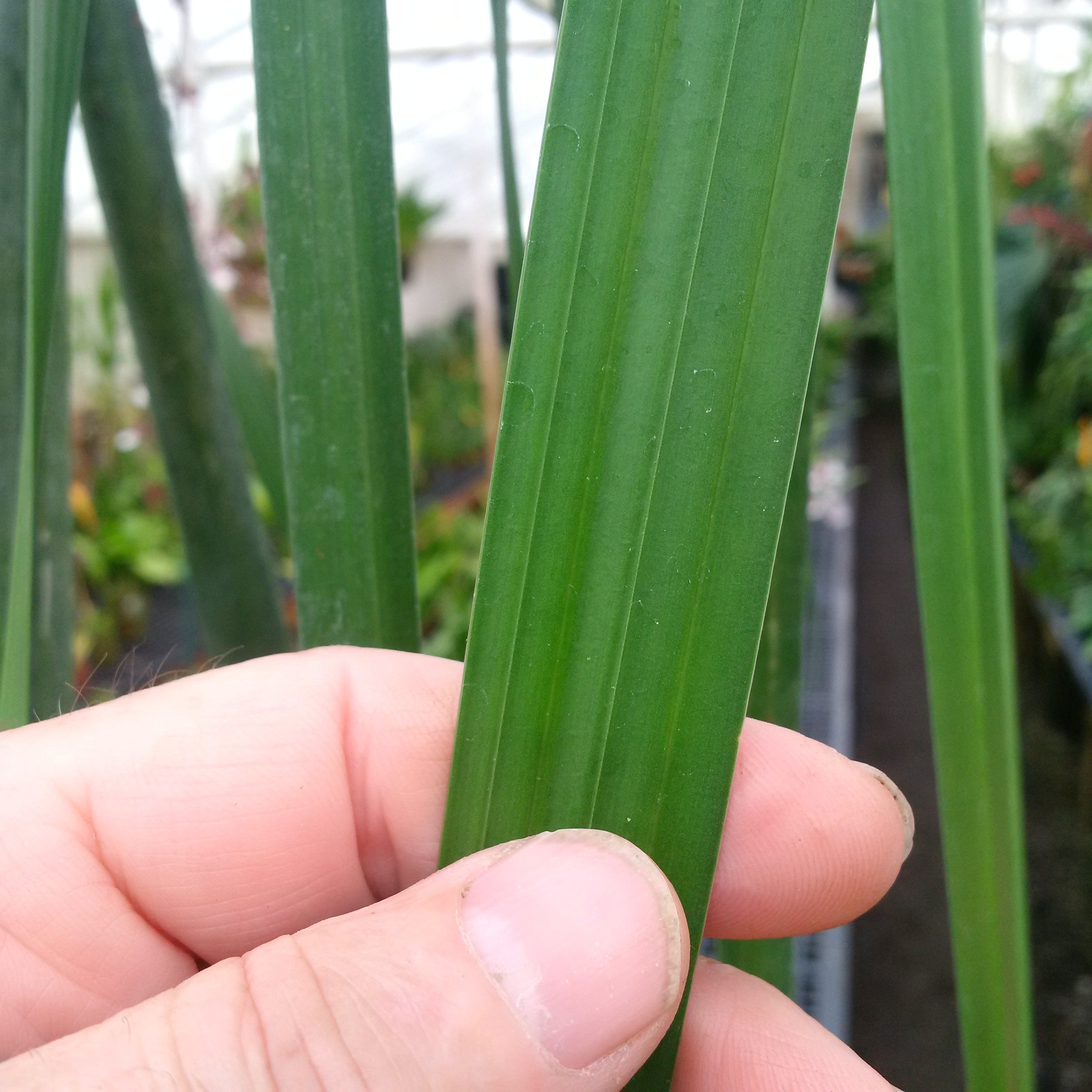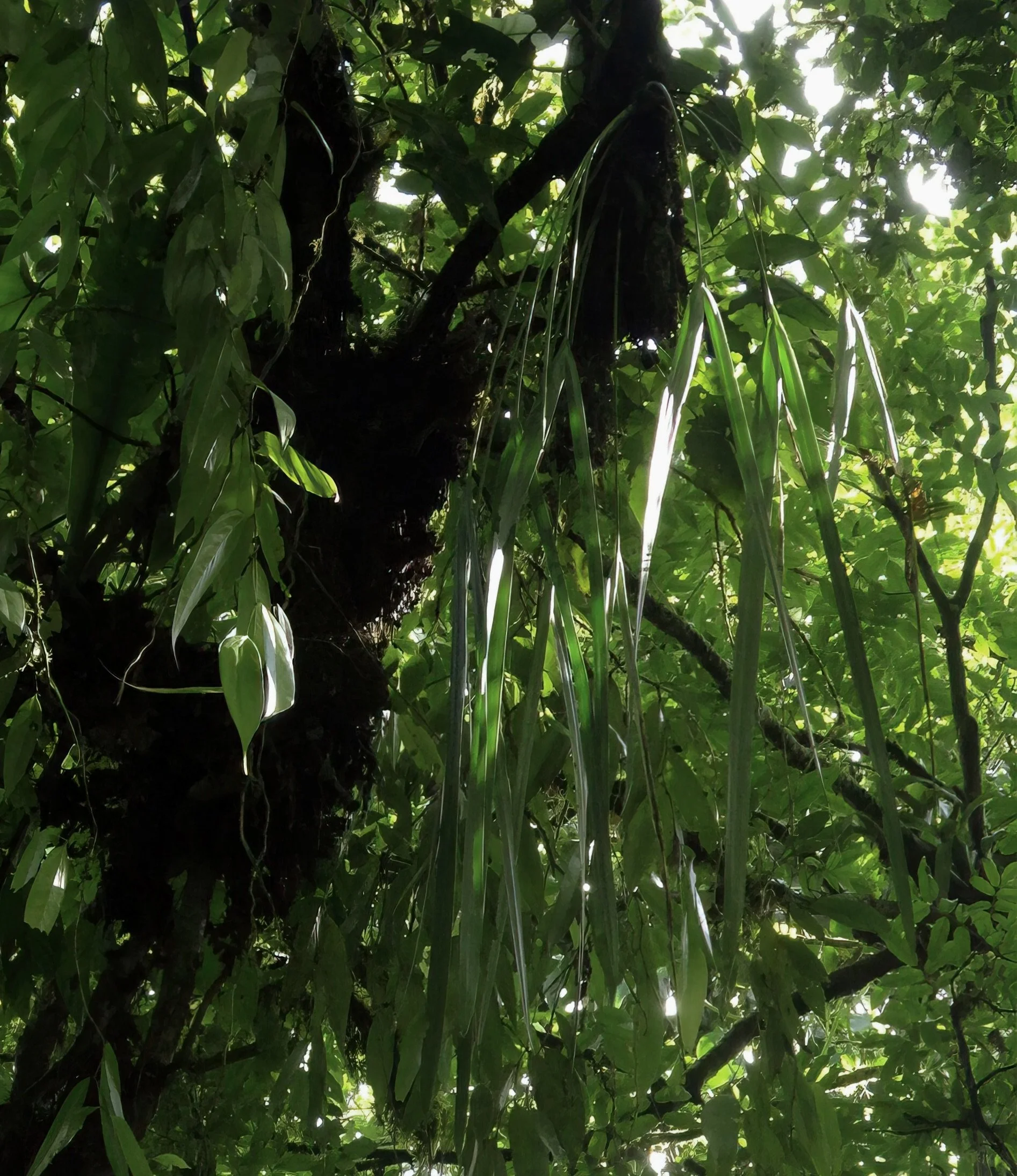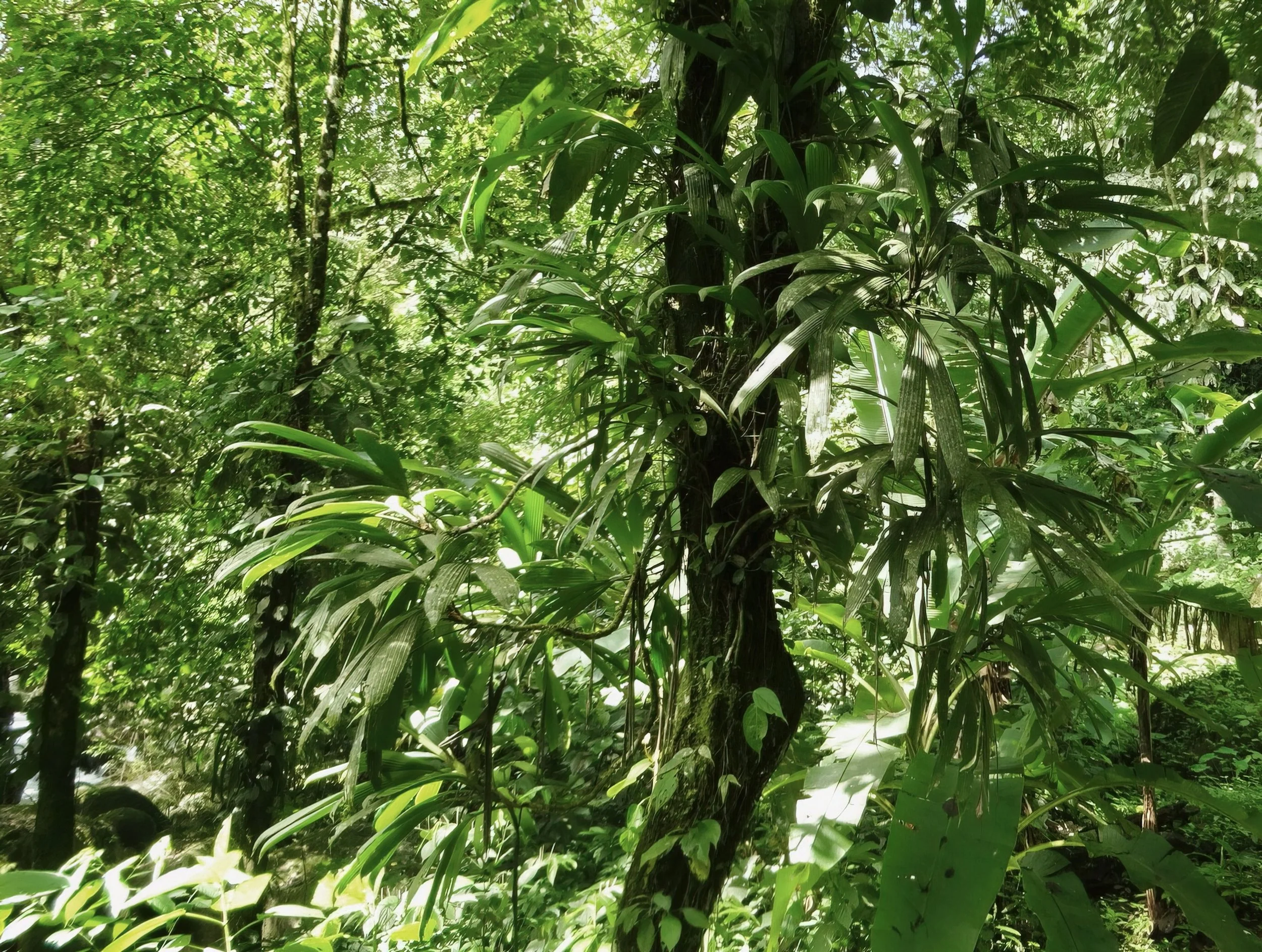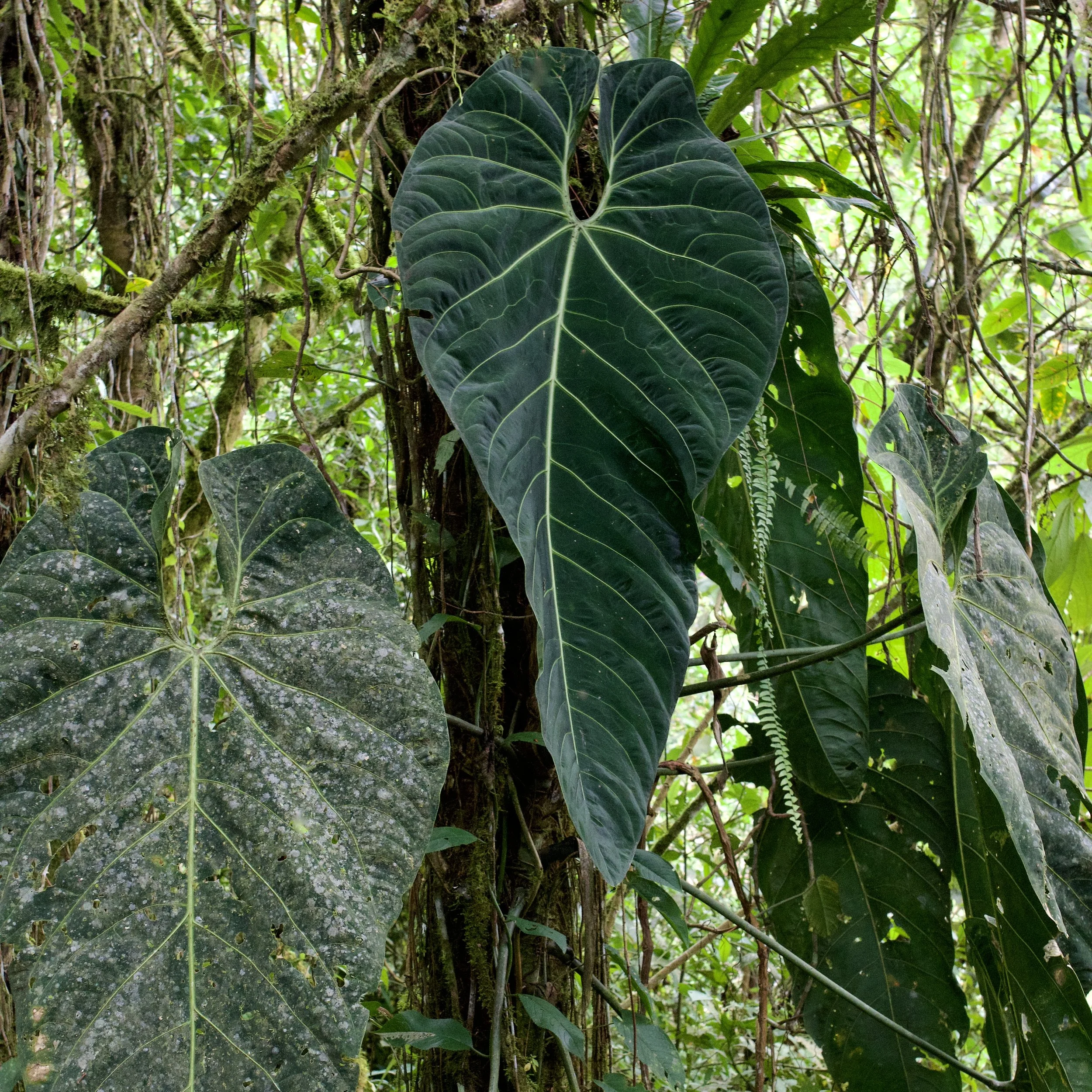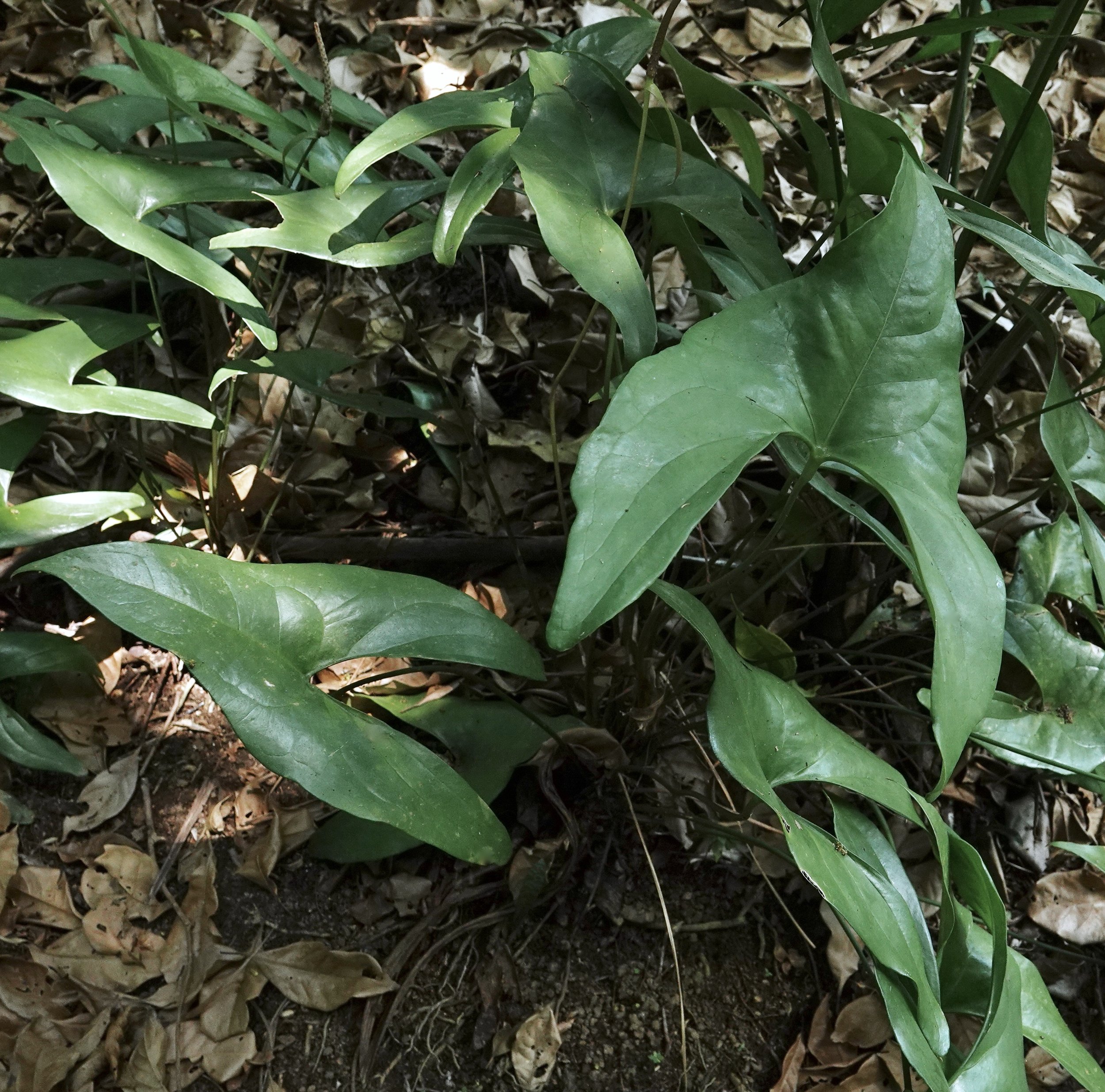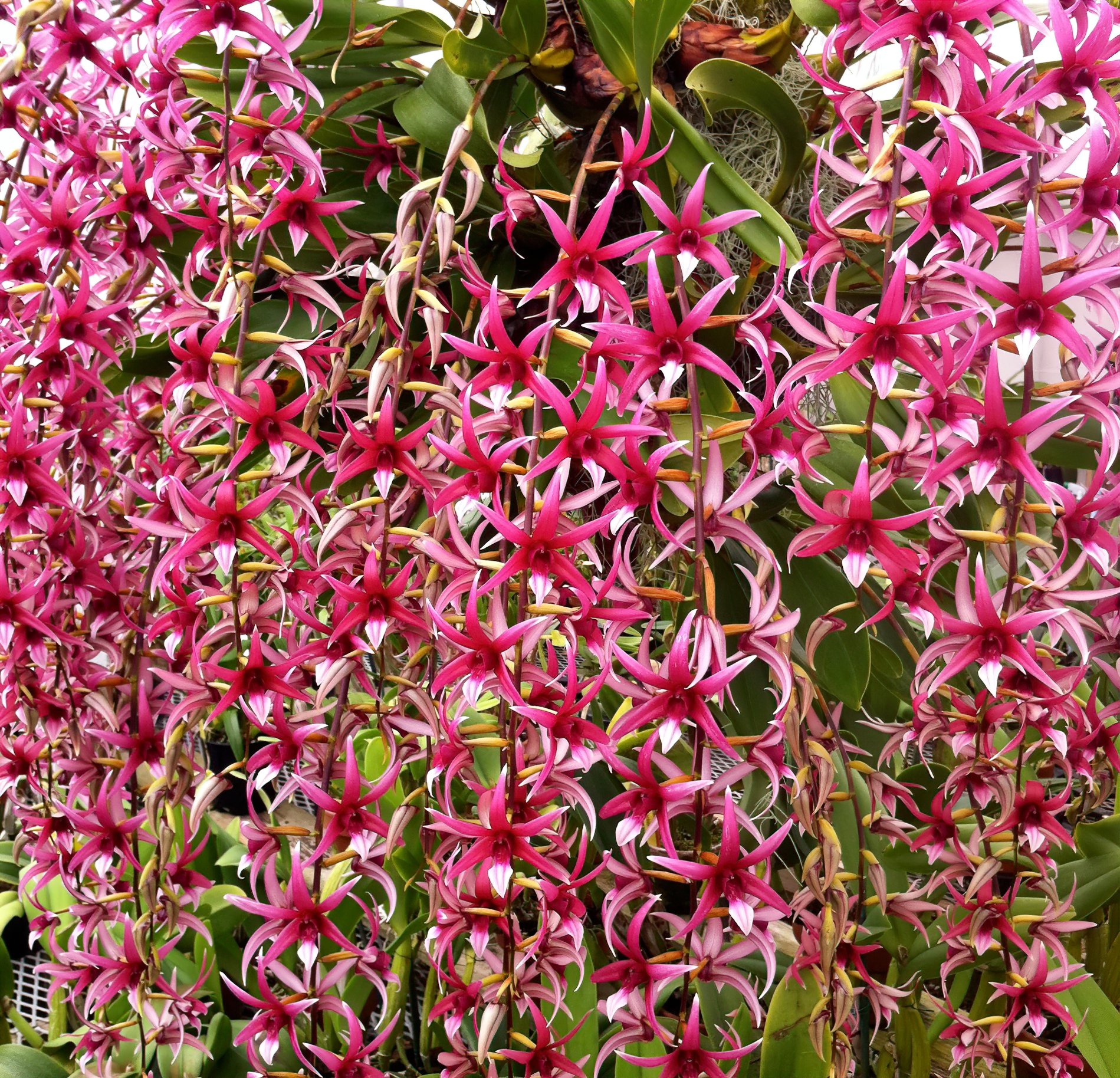Cultivating dwarf cyclanths: the right-sized "palms" for home and terraria?
Palms in terraria?
And just what is a cyclanth?
by Jay Vannini
Leaf detail of Dicranopygium microbullatum, Panamá. Image: ©Fred Muller 2018.
Good questions.
While cyclanths are indeed monocots just like their well-known occasional lookalikes the palms, they are quite unrelated and are in fact part of the Pandanales. Being placed in this rather obscure Order puts them in the same group as the somewhat more familiar Old World screw-pines or pandans. Ubiquitous residents of shaded areas in warm, wet forests throughout the New World tropics, cyclanths have long been ignored by ornamental horticulture. The first monograph on the family, published 65 years ago, cited only 20 species of cyclanths in cultivation at that time, most of which were in the collections at the Royal Botanical Garden at Kew in England (Harling, 1958). Some of this lack of interest by horticulturists can be attributed to a notable scarcity of living material available to interested collectors, although this is now slowly changing. Then there is the bewildering similarity of a number of the terrestrial genera/species, many of which are near lookalikes that defy determination unless one is a specialist lucky enough to find them flowering. Finally, cyclanth seed is tiny, notoriously fragile and very short-lived, as well as rather tricky to germinate.
Just how unfamiliar are they to most growers? An acquaintance, a very well-respected plantsman who curates one of the world’s largest live tropical plant collections, has chosen cyclanths as a medal winner in his, “Plants without Fan Clubs” category. Over the years I have had any number of otherwise knowledgeable orchid, bromeliad, and succulent collectors come up blank when I show them my cyclanths at the greenhouse. Palm growers are forever confusing some of them with – here's a shocker – palms, prompting the occasional wild goose chase by collectors following reports in the Neotropics of a strange-looking new palm species that when finally encountered turns out be not a palm at all, but rather a terrestrial cyclanth.
A colony of Dicranopygium microbullatum, rheophytic in lowland tropical rainforest, Panamá. Image: ©Jay Vannini 2018.
The Cyclanthaceae is by no means some tiny, obscure plant family, although they do have relatively few researchers working with them. Many species are known from only the type series, and the larger species are difficult to preserve. There are currently about 240 accepted species known from a dozen genera (Hammel & Grayum, 2022a; Plants of the World Online, 2023). Given their similarity in the field, patterns of local endemism, and a cascade of recent discoveries, it is probable that this list will be increased significantly over the next decade. Centers of diversity are located in wet forests at lower and middle elevations of Costa Rica and Panamá, Colombia to Perú, as well as western Brazil. Several species are known to occur at higher elevations, including a couple interesting ones that manage to eke out an existence above the treeline in Andean páramo.
Famed U.S. ethnobotanist and author Richard Evans Schultes (d. 2001) was one of the few early 20th century researchers who consistently collected and preserved cyclanths wherever he worked. Schultes clearly had a keen eye for novelties. His extensive and well-prepared collections of Cyclanthaceae from the Upper Amazon of Colombia and NW Brazil were praised by Gunnar Harling, and he was honored with a monotypic cyclanth genus that was named after him (Schultesiophytum) for his fieldwork with the family (Harling, 1958).
Fibers from a few species are used to make Panama hats in Ecuador (where, rather confusingly, the genuine article is made), Colombia, Honduras, and Panamá (which – ironically – doesn’t actually make true “Panama” hats). Cyclanth fiber may also be used to manufacture furniture and bags (Harling , 1958; pers. obs.). In the region they are commonly known as “toquillas” (pronounced “toe-key-yas”) or “jipijapas” (pronounced “heepy-hapas”). Throughout their range the boiled or grilled hearts of new stems of members of the genus Carludovica are utilized both as snacks or famine foods by rural people. Most of the climbers and liana-types have narrow but very strong stems and scaffold roots that are routinely harvested and used as ties and ropes by indigenous people and campesinos.
Carludovica rotundifolia dominating lowland rainforest understory in Colón Province, Panamá. Image: ©Fred Muller 2018.
Besides being often difficult to identify with certainty (even to genus in many cases when not in flower), some cyclanths also present practical challenges to private collectors interested in growing them indoors due to their rapid growth and ultimate size. Many, particularly some of the terrestrial and hemiepiphytic species, are quite a handful at maturity. Some can attain imposing final dimensions in nature (e.g., Thoracocarpus bissectus, Sphaeradenia gigantea, and Asplundia pycnantha). These require a very large tropical greenhouse or plenty of sheltered warm garden space to look their best. Most public gardens around the world that have walk-through hothouses usually have at least one cyclanth species in their tropical forest exhibits, usually a Ludovia, Carludovica, or an Asplundia species of one type or another. None of them, honestly, will do much to make a rare plant grower’s pulse racing. These “Plain Janes” of the family are the reason many public garden curators yawn when cyclanths are mentioned as potential display items. They tend to be more popular with botanical gardens located in fully tropical settings where they can be kept outdoors year-round and can be grown to full size without elbowing out the rest of the collection.
Dicranopygium microcephalum, showing a common cyclanth habit, a relatively short-statured plant with all green, bifid leaves. Izabal Department, Guatemala. Image: ©Jay Vannini 2018.
At this time, it appears that US public gardens with good representative collections of cyclanths off-exhibit now include Fairchild, Marie Selby, and Atlanta Botanical Gardens. The Huntington in Pasadena, California also grows several interesting cyclanth species.
Leaf shapes vary, but most species are bifid (fishtail), with a few that are tripartite, palmate or simple (undivided), including the entire small genus, Ludovia. Seedlings and very young plants of species that have divided leaves as adults usually have simple leaves.
To date, one unremarkable species (apparently either Asplundia rigida or A. insignis) has made an irregular commercial appearance from micropropagation. It still shows up sometimes at garden centers around the world as ‘Jungle Drums’. Aside from being a less-than-spectacular-looking selection, this offering has also suffered the misfortune of being regularly misidentified to this day as belonging to a quite different genus of more commonly-seen cyclanths, Cyclanthus or Carludovica.
Like most cyclanths, ‘Jungle Drums’ is inflexibly cold intolerant and gardeners who trialed it outdoors in non-tropical regions usually awoke to them being melted the first time they spent a few hours around 40 degrees F/4.4 degrees C.
Dicranopygium sp. cf. harlingii "Dwarf Violet" growing in very shallow standing water, Panamá. Image: ©Fred Muller 2018.
Dicranopygium curvitepalum, Chiriquí Province, Panamá. Image: ©Fred Muller 2018.
Identification of cyclanths at species level relies heavily on examination of their reproductive parts under low magnification. The depth of the clefts in mature leaves are also a useful key character for many species. Despite their often bewildering morphological similarity, there are a few tips to differentiating the genera that are of most interest to tropical plant collectors when inflorescences are lacking. See the modified key by Gentry below for additional information.
Cyclanthus (2 spp.), Ludovia (3 spp.), and Carludovica (4 spp.) are all distinctive and fairly easy to identify to genus from leaves alone. The four monotypic genera – Evodianthus, Thoracocarpus, Dianthoveus, and Schultesiophytum – are all bifid leaf plants with the first two genera being hemiepiphytic and the latter pair being large terrestrials or lithophytes from Ecuador just into southern Colombia and northern Perú. Thoracocarpus may be confused with several other bifid leaf genera when young, but once they start climbing their overall morphology and dense clusters of long, ropy adventitious roots emerging from below the leaf nodes, together with conspicuously sulcate petioles, are helpful key characters. It is likely the largest species of cyclanth overall; certainly it’s among the tallest (pers. obs.).
There are three genera whose leaves are arranged distichously (i.e., emerging alternately from one another on a single vertical plane); Stelestylis (4 spp.), Chorigyne (7 spp.), and Sphaeradenia (52 spp.). All members of these genera are large to extremely large at maturity and have fairly stiff to rigid, conspicuously plicate leaves. Two of these genera are fairly frondose and mostly encountered in nature growing as subcanopy terrestrials or epiphytes. Chorigyne is endemic to Central America, ranging from northern Costa Rica along both coasts to extreme eastern Panamá and – while fairly commonly-observed epiphytes at some lowland rainforest parks and private reserves in the region – is rarely encountered in horticulture. Stelestylis is restricted to the Guianas and Upper Amazon and appears to be held at only a handful of public gardens. The third genus of this trio, Sphaeradenia, ranges from Nicaragua to northwestern Bolivia and are usually denizens of intermediate and high elevation cloud forests. While all are attractive, the large mature size and colonial habit of these plants makes them unsuitable for collectors that lack wet tropical garden settings or climate-controlled greenhouses.
The last two genera in the family are the most species-diverse of the family and include many of the rarer and choice species of cyclanths in cultivation. They are the wide-ranging genera Dicranopygium (~55 spp.) and Asplundia (~105 spp.). In the field, it is a safe bet to assume that any rheophytic cyclanth you come across will be a Dicranopygium species, and these also tend to be smaller than most Asplundia. A small number of Dicranopygium species are at least occasionally hemiepiphytic, but the overwhelming majority are colonial rheophytes, lithophytes, and terrestrial plants from warm, dripping wet, shady settings. In flower they may be readily distinguished from Asplundia by their spathe arrangements, which are attached to the lower edge of their spadices rather than being scattered in alternate ranks at the upper end of the peduncle. Many of the larger Asplundia species can be identified to genus in the field when sterile due to their basal leaf vein arrangements, which are commonly (but not invariably) tricostate or subtricostate. Note that Schultesiophytum, an Upper Amazonian endemic genus, also possess broad and conspicuously tricostate leaves and an erect habit.
Alwyn Gentry (1996), provided a simplified key to the genera of Cyclanthaceae of northwestern South America, an expanded version of which I present here that incorporates distributional updates, additions, and modifications that include authors and descriptions of two genera missing from his treatment.
Mature leaves* undivided and with only a single (or no) well-developed midrib; there is normally a single exception – Cyclanthus indivisus – that has undivided, elliptic leaves but with two strongly developed parallel midribs > Ludovia Brongn.
Mature leaves palmately divided**, usually into four main segments, with less deeply divided lobes > Carludovica Ruiz & Pav. and a few rather rare Costa Rican, Panamanian, and Colombian Asplundia spp. with multi-segmented, deeply-divided leaves, e.g., A. allenii and A. aurantiaca
Mature leaves bifid >
Cyclanthus Poit ex A. Rich. = always terrestrial; unique in possessing thickened midribs on each segment of the deeply bifid leaves; undivided leaves with paired midribs in the single Cyclanthus sp. from Panamá, Colombia, and Perú mentioned in section 1
Asplundia Harling = terrestrial and hemiepiphytic; mostly bifid leaves arranged spirally on stems; unicostate, subtricostate, or tricostate leaf blades; inflorescences with three to five spathes (or their scars) clustered or scattered along upper peduncles, sometimes to their mid-lengths
Dicranopygium Harling = terrestrial, rheophytic, and hemiepiphytic; differs from Asplundia in leaf blades being invariably unicostate; tiny to several (3-4), small, few-flowered inflorescences with a single spathe or spathes clustered at the base of the spadices
Evodianthus Oerst. = terrestrial (rarely) and hemiepiphytic; leaves scabrous when dry as in Dianthoveus; three (rarely four) spathes crowded at the bases of the spadices; free pistillate flowers
Dianthoveus Hammel & G. J. Wilder = lithophytic and terrestrial; conspicuously frondose in nature; leaves scabrous but much larger than those of Evodianthus
Thoracocarpus Harling = hemiepiphytic; wide, deeply concave petioles; differs from Asplundia in having eight-11 spathes or scars on their peduncles rather than (usually) three to five in scandent Asplundia spp.
Sphaeradenia Harling = terrestrial and epiphytic; mostly stiff, distichous two-ranked leaves; differs from Asplundia but similar to Chorigyne in having thick, glossy leaves
Chorigyne R. Ericks. = epiphytic; genus endemic to Costa Rica and Panamá, distichous two-ranked leaves that are fewer per stem and generally with lower numbers of primary veins than in Sphaeradenia and Stelestylis.
Stelestylis Drude = terrestrial and epiphytic (rarely) in Venezuela and the Guianas; stiff, distichous two-ranked leaves; elongated peduncles; fusiform, winged seeds
Schultesiophytum Harling = terrestrial in northwestern Amazonia; tricostate leaves bruising and drying black; inflorescences with elongated peduncles and free pistillate flowers
A handsome but confusing small hemiepiphytic cyclanth (undescribed?) from warm cloud forest at 5,850’/1,800 masl elevation in Risaralda Department, Colombia that shares leaf characteristics of both Asplundia and Dicranopygium. Drip tip leaves to ~5”/13 cm in length that lack a noticeable midrib favor placement in Dicranopygium, while overall Gestalt and short peduncle remnants suggest it is an Asplundia sp. In rare examples such as this one, only careful examination of fresh inflorescences–sadly lacking when I found this plant–can resolve correct generic placement. Image: ©Jay Vannini 2024.
Developing infructescences on an Ecuadorean Asplundia sp. cf. alata showing three conspicuous scars below the spadix and spaced along the peduncles below where the spathes were (briefly) located when the structure unfolded. The number and location of the spathes or their scars are diagnostic and will segregate Asplundias from Dicranopygium species. Author’s plants. Image: ©Jay Vannini 2024.
Fortunately, since 2015 and as more species have become available, the family has witnessed a notable uptick in interest by rare tropical plant collectors. This has largely been due to the efforts of Fairchild Tropical Garden’s chief horticulturist, Chad Husby who, together with cyclanth specialists Barry Hammel, Michael Grayum, and Roger Eriksson, have probably done as much to spur contemporary interest in the family since Danish botanist Gunnar Harling published his monograph on the family in 1958. Chad Husby not only painstakingly consolidated accessions of almost all of the cyclanth species that were being grown in US, EU, and Asian public gardens in the late 2010s, but also reached out to the very few private collectors in the US who had noteworthy collections lurking outside of the public domain to find out who had what. Beginning in 2016, a number of new, relatively compact NW South American cyclanth species have also entered cultivation from commercial imports of wild-collected plants, including a few very interesting and attractive ones shown below.
A large, aberrant Cyclanthus bipartitus growing in high elevation cloud forest of Cundinamarca Department, Colombia. A close look at the image shows that this rather confused plant produces both the typical, deeply bifid leaves that are characteristic of this wide-ranging species, but also many fully fused/simple leaves that resemble those on C. indivisus from lowland tropical rainforests of Panamá, Colombia, and Perú. Image: ©Wilson López 2024.
It is worth noting that there are large numbers of images of misidentified cyclanths posted online. Beyond these, I have received material from respected botanical gardens that were misidentified to genera, so it is worth comparing live material in one’s collection with formal descriptions. For some reason one of the most easily-identified species, Ludovia integrifolia, seems to generate the greatest confusion.
*Note that most seedling cyclanths from all genera have simple/undivided leaves, while young Carludovica spp.** usually have bifid leaves.
A young Asplundia alata on red clay soils in Panamanian lowland rainforest. This wide-ranging terrestrial cyclanth can attain impressive sizes in some areas, with Panamá Canal area specimens reaching at least 6.5’/2 m tall and 8’/2.5 m wide. Like many of the larger Asplundia species, A. alata has subtricostate leaves when immature and conspicuously tricostate leaves when mature. Inflorescences are sessile or short pedunculate, with three to four spathes. It is occasionally available in the rare plant trade as imports from Ecuadorean nurseries. Its mature wingspan make it best suited for fully tropical garden settings. Image: ©Jay Vannini 2023.
Selections
Dicranopygium stenophyllum, plant and maturing inflorescence shown below. From low and intermediate elevations of Ecuador and Perú, With >24"/60 cm very glossy and plicate leaves, it is probably more suited to public and greenhouse displays than terraria but is doable in a large tank. Pictures here do not do it justice. Like the somewhat similar-looking rheophyte, D. tatica from Costa Rica and parts east, a genuinely beautiful plant in hand. An open inflorescence (briefly) has the added attraction of a wonderfully strong scent of ripe raspberries! Nearly mature bud shown. Its inflorescence is ephemeral and the plants exhibits nocturnal-early morning flowering. Author’s plant and image: ©Jay Vannini 2018
I am still working on a final ID for the plant shown below, which is almost certainly Asplundia xiphophylla or a close relative. From foothill forests of Morona Santiago Province, Ecuador, this is an elegant and very delicate-looking warm-growing hemiepiphyte with pencil-thick plus stems covered with soft spine-like projections emerging from the internodes. Offhand, I don't recall having seen this adaptation before on a cyclanth, but some pandans can develop quite formidable spines on their leaves and stems. Due to its relatively compact footprint, it seems a great candidate for pot cultivation in smaller spaces but needs some headroom. It responds well to pruning and suckers vigorously in youth. Leaves break/crease permanently with surprising ease, so care is needed when overhead watering with a breaker. Eminently suitable for vivariums housing very lightweight regional herps (e.g. anoles-Dactyloidae, glass frogs-Centronelidae and clown tree frogs (Dendropsopus leucophyllatus-Hylidae). Author’s plant and images: ©Jay Vannini 2018.
Below, the hemiepiphytic Asplundia cf. vaupesiana shown below is still in limited circulation in the US, but deserves to be much more widely-cultivated. I originally received it from two separate sources in the mid 2010s as Ludovia integrifolia. The species is known to be widespread in low elevation rainforest across the Upper Amazon in southern Venezuela, southeastern Colombia, northeastern Perú, and much of western and central Brazil. I believe that I saw "Costa Rica" as the supposed origin on one of the mislabeled tags that I received, but it doesn’t match any cyclanth species that are known to occur in Central America. When young, it can grow for some time producing only entire leaves (shown below right and next set of images), so it is superficially similar to that plant when immature. It appears that a few university and public gardens still have it in their inventories either misnamed to genus/species or associated with an incorrect country of origin. Easy to grow, prune and propagate, with mature leaf size ~12/30 cm. I am trialing a multi-stemmed 20"/50 cm tall one in a vivarium with a pair of fringed leaf frogs (Cruziohyla craspedopus) and its sole drawback in vivaria seems to be that emerging foliage can be chewed a bit when too many feeder crickets are loaded in the enclosure at once. I also grow a somewhat similar-looking Ecuadorean import that lacks rippled leaf blades, so an apparently undescribed, close relative of this species apparently occurs there at middle elevations in the southeast.
Cutting-grown, multi-stemmed Asplundia sp. cf. vaupesiana shown above, juvenile leaf phase, rooted in pure NZ sphagnum in a plastic basket in lightly planted vivarium together with two of the wildly shy, Godzilla wannabe - but startling beautiful when outstretched and showing orange lateral flash marks - upper Amazonian fringed leaf frogs (Cruziohyla craspedopus). Author’s plants, frogs, and images: ©Jay Vannini 2018.
There are several new or relatively new introductions to horticulture that are quite suitable for 24" x 18" x 18"/60 cm x 45 cm x 45 cm terraria and paludaria. Two of these are the very handsome Dicranopygium species shown below both captive and wild, one from northeastern Ecuador (terrestrial, top two rows of images with the in situ shot below right courtesy of I. Portilla), and the other from Panamá (rheophytic, fourth image row). Both are lowlanders from tropical near-pluvial forests. Overall heights between 6-14"/15-35 cm. They offset vigorously and can be grown to specimen size in 8-10"/20-25 cm bulb pans. As is shown in the image taken of the Ecuadorean dwarf species in nature, more than any of the other miniatures, it can present the optical illusion of having distinct cross-bands on the leaves with the right conditions and feeding. The Panamanian species (D. minimum) is also very glossy-leafed and appears to be the smallest known cyclanth, with individual crowns measuring ~8" x 4"/20 x 10 cm at maturity. Author’s plants and images: ©Jay Vannini 2018.
Some terrestrial Dicranopygium species can be surprisingly fast-growing. The specimen shown above was grown from a very small start acquired from a commercial Ecuadorean source in late 2016. In about two and one-half years this plant has almost filled out a 10”/25 cm bulb pan. High humidity, warmth and daily misting/watering with pure water are recommended to succeed with these beautiful rainforest plants. Author’s plant and image: ©Jay Vannini 2018.
Another recent introduction from low and middle elevations of southern Colombia, Dicranopygium omichlophilum, is shown above. Early collections were made from streamsides or seasonally submerged localities in warm tropical ecosystems, but later accessions identified as this species were found growing as short-statured hemiepiphytes in cloud forests. This handsome, slowly-clumping dwarf cyclanth with papery leaves grows to just over 2’/60 cm tall and is one of the more desirable but difficult to grow members of the family. Author’s plant and image: ©Jay Vannini 2023.
Above, Dicranopygium minimum in cultivation and growing stream-side in nature in central Panamá. This is perhaps the smallest known species of cyclanth. Images: @Jay Vannini and ©Fred Muller 2018.
And then there is the coveted purple-black beauty from Panamá, Dicranopygium sp. cf. harlingii. "Dwarf Violet".
Dicranopygium sp. cf. harlingii "Dwarf Violet", shown alongside a slow-running rainforest creek. Image: ©Fred Muller 2018.
This is the most striking and desirable cyclanth (or even small palm?) in cultivation, but it is admittedly a bit tricky until you learn to grow it. This species despises being exposed to even moderately cool temperatures, bad water, low humidity, too much fertilizer, being root-bound, general neglect, etc. Once you get it in its groove though, a well grown group is traffic-stopping in a mixed collection. Maximum size for an individual rosette ~11"/28 cm, but it is colonial over time. It excels when grown in net baskets with its roots submerged in warm, misted tropical terraria, but was a total bust as an immersed aquatic in Guatemala when trialed by a very skilled aquarium plant grower (P. Rockstroh). I first collected seed from this species 18 years back, and have cultivated it on a continual basis ever since with greater and lesser degrees of success. In spite of some mishaps along the way, I have now produced artificially propagated plants to third generation. Below, flowering and fruiting in California earlier in 2018 (below left) and a mossy compot of domestically-produced one year-old seedlings photographed here in late July of the same year (below right). Note the metallic luster on the still entire leaves of seedlings.
Largest example shown in the compot is about 0.75"/2 cm across.
This lowland rainforest Dicranopygium species has at least four distinct color forms known from disjunct localities. The best known form in cultivation is, of course, the blackish violet one shown in images above and throughout the article, but there is also this brownish-green or cocoa-brown form shown above found growing at lower elevations closer to the Caribbean coast in the same general region. Another form with dark green leaves and maroon petioles is shown below in my U.S. collection. These less-commonly seen leaf color variants are also now in limited cultivation in the U.S. The taxonomic status of all these plants remains somewhat controversial. Barry Hammel, an authority on the genus, recently confirmed his previously-expressed view that they are all just local forms of D. harlingii, which was originally collected from a locality 1,300’-2,300’/400-700 m higher than the various wild plants shown in this article at Altos de Pacora by Robert Dressler and George Wilder, with their leaves described as being, “…dark green above and pale below” (field notes on Dressler No. 4588B; Wilder, 1978; B. Hammel, pers. comm.). If, as their floral features suggest, all these populations are indeed examples of D. darlingii then this species shows a remarkable range of color variants in a small geographical region that is otherwise unknown in the family (pers. obs.). For now, I follow Barry Hammel’s determination and label them all as either D. harlingii or D. sp. cf. harlingii. Images: ©Fred Muller 2018 and ©Jay Vannini 2018-2023.
Shown below is a very beautiful ripple-leafed Dicranopygium sp. from the Putumayo Department of southern Colombia that originated from a small division of an accession cultivated at Marie Selby Botanical Gardens in Sarasota, Florida. It appears to be part of the D. cuatrecasasianum species complex that includes a number of taxa occurring from Costa Rica through to Ecuador. Leaves fairly stiff with a very plastic-glossy aspect. Predictably, it sulks a bit when kept cool, but – mercifully – is not prone to brown-tipping. It is relatively straightforward when grown warm with lots of water in a shallow pan-substrate combo that let its roots run free. This one is a bit confused-looking while recovering from a delayed transplant. It is lust-inducing to see in person when it is thriving. Perfect for advanced terraria keepers, but still rare in cultivation and hard to obtain if you're not well-connected with the very few people who grow it. Author’s plant and image: ©Jay Vannini 2023.
Dicranopygium felinum, lowland rainforest, western Panamá. Image: ©Jay Vannini 2018.
Another closely-related Dicranopygium species is shown below, apparently originating from the lowlands of northeastern Ecuador. There are several of these morphologically similar, dwarf cyclanths from this region that all have axillary inflorescences (D. cuatrecasasianum has pedunculate inflorescences, but is vaguely similar-looking). I only have a couple clones of this particular species, but so far it seems remarkably unfussy for such a delicate-looking plant. Like all members of this group in my collection, a warm grower potted in mineral substrate in a bulb pan. Compare this miniature cyclanth to images of some of the dwarf Chamaedorea palms shown in another section on this site to gain an insight into how even experienced palm growers can get bamboozled by these plants at first glance under field conditions. Author’s plant and image: ©Jay Vannini 2018.
Below, a very attractive small rheophyte ranging along the Caribbean lowlands from Costa Rica to western Colombia is Dicranopygium tatica. Like several of the central Panamanian members of this genus that also inhabit tropical rainforest streambeds, I have found this species to be a bit slow and temperamental if temperatures are too cool, but otherwise it is of easy culture. Still rather rare in cultivation, but starting to show up in different U.S. public gardens where it will no doubt filter out to other private collections. The young plant shown below is just starting to offset and is unfurling a new inflorescence. Author’s plant and image: ©Jay Vannini 2018.
An Asplundia schizotepala from the Loreto Region of Perú ripening an infructescence in a California greenhouse. Note the striking resemblance to the pineapple-like fruit of many Old World pandans that are distantly related to it. Author’s plant and image: ©Jay Vannini 2018.
Rather ruefully I have to admit that as a former fieldworker in Central American tropical forests I was never much attracted to cyclanths. They are EVERYWHERE in diverse under-canopy humid and wet ecosystems throughout much of Latin America and, after a while, together with common palms, just become a blurred part of the general “tossed green salad” in the background. This changed abruptly when I came across the very beautiful, metallic violet semi-aquatic/rheophytic miniature species in Panamá shown and discussed here that has since found its way into very limited terrarium and shadehouse culture in the US, Australia, Canada, and Asia. Since this discovery almost two decades back, I have built a fairly diverse collection of the smaller cyclanth species, almost all of which originated from Costa Rican, Panamanian, Ecuadorean, and Colombian accessions. At the time this article was written I grow 33 species representing six genera. While a number of these species do achieve very large sizes when given enough space, eight or nine species of the sixty or so known members of Dicranopygium, as well as a handful of Asplundia species and Ludovia integrifolia appear to have excellent potential as permanent terrarium inhabitants that will not outgrow their enclosures. Most of these species are either true rheophytes or live on rocks or clay banks adjacent to fast-flowing streams that generate a lot of spray when in flood.
Growing by the thousands in and along a waterfall and limestone based stream in rainforest on Guatemala’s Caribbean coast, Dicranopygium gracile subsp. gracile are well adapted to survive periodic river scouring that occur during tropical storms that are frequent in this area. Image: ©Jay Vannini 2018.
Rheophytic Dicranopygium gracile subsp. gracile subject to frequent submersion develop pliant, hydrodynamic leaves and sturdy root systems from an early age. Photo taken in nature, Izabal Department, Guatemala. Image: ©Jay Vannini 2024.
The widespread Costa Rican and Panamanian Dicranopygium wedelii is a commonly-encountered rheophytic cyclanth in regional streams at lower and middle elevations along the Caribbean foothills. This species is relatively easy in cultivation. Image: ©Fred Muller 2018.
Dwarf, rheophytic Dicranopygium sp., Bocas del Toro Province, Panamá. Image: ©Jay Vannini 2018.
Even fairly robust rheophytes can get thrashed by flooding as a result of severe tropical storms. A streamside colony of an otherwise nice-looking, smallish Dicranopygium sp. in tatters following a series of violent summer and fall storms along the Caribbean coast of Costa Rica in the fall of 2018. Plants located closer to the center of the stream at this site were completely stripped of their leaves. Image: ©Jay Vannini 2018.
Sphaeradenia praetermissa, Veraguas, Panamá. Image: ©Fred Muller 2018.
Although not particularly suitable for most small private collections, there are also several very striking epiphytic cyclanths in the genera Chorigyne, Stelestylis, and Sphaeradenia in limited cultivation - and mostly in public gardens - that make superb display subjects if you have the space and greenhouse conditions for them. Most notably, the long-leafed Caribbean lowland Costa Rican and Panamanian C. pendula and C. cylindrica are extremely handsome and attention-getting plants for large hanging baskets or mounted on tree branches in walk-through greenhouses. They would certainly be popular in broader exotica cultivation with specialist tropical palm and aroid growers if seed-grown material ever becomes available.
A mature example of the (mostly) canopy epiphyte mentioned above is shown in two images below, the lowland rainforest cyclanth Chorigyne pendula stretching its wings in a cool tropical greenhouse in California. Leaf lobe detail shown on right. Leaves and petioles to ~6'/1.85 m in length in fully mature examples. In western and central Panamá, this species often occurs together on the same tree with two other very coveted long-leaf ornamental standouts, Anthurium wendlingeri (Araceae) and Zamia pseudoparasitica (Zamiaceae). Author’s plant and images: ©Jay Vannini 2018.
Growing media suitable for cyclanths can be divided into three categories:
Chorigyne pendula in lowland rainforest high canopy, Panamá. Image: ©Jay Vannini 2018.
- Pure, high-grade (read, “New Zealand”) sphagnum moss, either pure or amended, is a suitable temporary substrate for establishing bare-root transplants of all species that I am familiar with. It is also an excellent permanent medium for the epiphytic species.
Hyuga, akadama and charcoal mix that I use for rheophytes and some terrestrial cyclanth species. Image: ©Jay Vannini 2018
- Fine grade conifer bark (I also prefer NZ origin) mixed with pumice/perlite and horticultural grade charcoal at a ratio of 3:2:1 has proven to be an excellent substrate for growing most terrestrial and climbing species.
- For rheophytes, after much trial and error over the past 15 years I have settled on a mix derived from bonsai culture of medium grade Japanese pumice (hyuga), mined Japanese clay (akadama) and horticultural charcoal also at a ratio of ~3:2:1.
Mixed colony of rheophytic Dicranopygium subdistichum and D. microbullatum in central Panamá. Image: ©Jay Vannini 2018.
Pots: I use 6-12"/15-30 cm diameter bulb pans for most of my collection, large net pots or plastic baskets for epiphytes, large plastic nursery pots for mature Sphaeradenia spp., and 3"/8 cm square plastic pots for propagating offsets of the miniatures. Plastic net pots for terraria/vivaria/paludaria.
Unsightly brown-tipping in cyclanths is usually the product of insufficient water, poor-quality water, cold, the wrong media or excess mineral salts. These plants, particularly the rheophytes, require prodigious amounts of water and humidity to thrive and are exquisitely sensitive to overfeeding. Pure water is recommended for irrigating all of the miniatures. Feeding should be light and infrequent. Liquid chelated iron feeds every three months or so at a very low concentration appear to enhance leaf and petiole color on many species.
Botanicare’s Cal-Mag Plus seems to be a good liquid feed for the miniatures. During periods of active I growth, I also do a monthly drench of Maxsea 16-16-16 at about one tsp/5 ml per gallon/3.8 lt of tap water, so ~90 ppm N. The more robust terrestrial and hemiepiphytic cyclanths tolerate Nutricote applications well. Epiphytic species and others being grown in pure NZ sphagnum moss can be drenched with Maxsea every three to four weeks, also at very dilute orchid strength.
Cork tube and coir-wrapped totems work well as supports for smaller examples of the climbers.
The main arthropod pests of cyclanths seem to be mealybugs, which are reasonably uncomplicated to deal with unless planted in a setting with live display animals in it. Slugs and snails find new very growth attractive and can seriously ding seedlings and plantlets, but are usually not a major problem long-term.
Cyclanths are pollinated in nature primarily by scarabs (Scarabaeidae) and weevils (Curculionidae). Fortunately, they do not appear to require species-specific associations since several genera have been pollinated by other families of small beetles, such as click-beetles (Elateridae) and others, in my collections in Guatemala and California. At least a few species that I grow are not self sterile and have set viable seed in both countries.
Sadly for some, it appears as if some of the higher elevation cloud forest species from southern Central America and the Andes require cool nights to survive. While high temperatures during the day don’t appear to bother them if nocturnal temperatures dip into the 50s or low 60s, sustained periods of hot daytime temps and warm nights (that means you, Miami, Singapore and Cairns!), will cause some to decline and collapse.
Light levels for the dwarf understory/rheophytic species should be kept in the 250-300 foot candle/2,690-3,230 lux range. Epiphytic species can readily adapt to light levels in the 750 foot candle/8,070 lux range or even higher.
Sphaeradenia purpurea inflorescence. Author’s plant and image: ©Jay Vannini 2018.
Chorigyne cylindrica is among the finest of all large-growing cyclanth species for display. The leaves are a deep glossy green in color, smooth and rigid like heavy plastic. While easy to cultivate, mercifully slow-growing, and offsets only sparingly, they do require plenty of room in a sheltered environment to reach mature sizes in pristine condition. This leaf perfect example is seven years old from a small, unrooted basal offset received on trade from a US botanical garden and has yet to flower, despite being 5’/1.5 m tall and almost 6’/1.85 m wide across leaf tips. Author’s plant and image. ©Jay Vannini 2023.
Dwarf cyclanths suitable for small terraria shown above at the typical size that I distribute them at in 3"/8 cm pots. Clockwise from top right, Dicranopygium sp. cf. harlingii "Dwarf Violet", D. microbullatum, D. minima, and D. sp. "Ecuador”. Image: ©Jay Vannini 2018.
Inflorescence of miniature terrestrial Dicranopygium sp. from Ecuador flowering in cultivation in July. The ephemeral pistillate staminodia of this species emit a very, very strong pleasant but ephemeral fragrance of ripe canteloupe lightly laced with acetone. Author’s plant and image: ©Jay Vannini 2018.
Sphaeradenia purpurea, developing infructescence. Image: ©Jay Vannini 2018.
Overall, this is fascinating family with a great deal of potential for tropical plants growers who can provide them with the space and conditions they require to thrive. There are several species that warrant being brought into cultivation by private collectors and/or public gardens as soon as possible. These include the striking Asplundia allenii from the lowlands of central and eastern Panamá, the recently-described A. callejasii from foothill forest in Antioquia, Colombia as well as Patric Blanc's (the green-haired bloke of vertical gardening fame) recently-discovered, apparently undescribed rheophytic Dicranopygium sp. with undivided leaves from near Nuquí, Chocó Province, Colombia. Images of it are shown on his website (www.verticalgardenpatrickblanc.com/inspiration/aquatics-and-rheophytes?page=10). Note that he is mistaken in stating on his website that this is the smallest cyclanth species. That title (for now), belongs to two central Panamanian rheophytic species shown here that can mature at ~6"/15 cm rosette diameters.
Mature inflorescence of Dicranopygium sp. Panamá in nature doing a pretty good imitation of a a charged plasma globe. Image: ©Fred Muller 2018.
A large terrestrial Asplundia sp. (perhaps A. longitepala) with decumbent stems and somewhat showy butterfly wing leaves. Risaralda Department, Colombia. Large cyclanth leaves can be surprisingly durable and persist on the plants for many years. Image: ©Jay Vannini 2024.
Unidentified Carludovica sp., Limón Province, Costa Rica. Image: ©Jay Vannini 2018.
Dicranopygium sp. growing as a terrestrial plant in disturbed elfin forest on Cerro Jefe, Panamá. Image: ©Jay Vannini 2018.
Newly-opened inflorescence on a Sphaeradenia rhodocephala from northeastern Ecuador showing the tightly-packed staminodes starting to expand. Author’s plant and image: ©Jay Vannini 2023.
Asplundia pittieri is a wide-ranging, medium-sized cyclanth that occurs from northwestern Costa Rica and Panamá discontinuously through to southwestern Colombia and likely includes at least two distinct species. New growth can be colorful at some localities. This individual from foothill rainforest in Central Panamá has violet newly emergent lower leaf color and pink upper leaf surfaces. Image: ©Fred Muller 2018.
Pollinated inflorescence of Cyclanthus bipartitus in central Perú. Image: ©Fred Muller 2023
Chorigyne cylindrica growing as a subcanopy epiphyte in disturbed elfin forest on Cerro Jefe in Panamá. Image: ©Jay Vannini 2018.
Sphaeradenia alleniana, leaf detail, cultivated plant in California. Red petioles of S.purpurea visible left background. Author’s plant and image: ©Jay Vannini 2018.
Inflorescence of a central Panamanian Evodianthus funifer at anthesis in the author’s California collection. This is a very wide-ranging and variable scandent species with four recognized subspecies: E. f. funifer, E. f. fendlerianus, E. f. peruvianus, and E. f. trailianus. Author’s plant and image: ©Jay Vannini 2018.
Cyclanthus sp. aff. bipartitus, Limón Province, Costa Rica. Several populations of Cyclanthus in southern Central America warrant further scrutiny. This particular ecotype remains quite small in life and flowers at a slightly larger size than this. Image: ©Jay Vannini 2018.
Backlit leaves and candy apple red petioles of a mature example of Sphaeradenia purpurea, cultivated in California. Author’s plant and mage: ©Jay Vannini 2018.
Asplundia sp., as a sprawling terrestrial in high elevation cloud forest Cundinamarca Department, Colombia. Image: @Jay Vannini 2021
High canopy colony of an extremely large cyclanth species, Sphaeradenia acutipetala, Puntarenas Province, Costa Rica. Image: ©Jay Vannini 2018.
A very attractive medium-sized, terrestrial Asplundia sp. cf. alata from Ecuador with tricostate leaves and reddish new growth. Although the deeply bifid leaves share superficial similarities to the those of the monotypic cyclanth, Schultesiophytum chorianthum, there are several asplundias that share this leaf morphology. Author’s plant and image: ©Jay Vannini 2018.
Thoracocarpus bissectus, lowland tropical rain forest, Panamá. Image: ©Jay Vannini 2018.
A young seed-grown example of the giant hemiepiphyte from the Chocoan lowlands, Asplundia pycnantha, growing in a California greenhouse. Due to its immense size at maturity, this species is only suitable for long-term cultivation in public garden conservatories and sheltered tropical gardens with tall trees. Author’s plant and image: ©Jay Vannini 2018.
Acknowledgements
A special thanks goes to Dr. Chad Husby of the Fairchild Tropical BG who, in 2015, rekindled my interest in collecting cyclanths after a decade of growing them more or less in isolation. Chad provided some important live material from global botanical gardens otherwise very difficult or impossible for me to obtain. Dr. Barry Hammel has been extremely helpful over the past few years in providing identifications for several cyclanth species that were difficult to provide names for; any lingering ID mistakes here are my own. He has also proven an invaluable resource for providing information on the family in general. Silvia and Mario Palmieri of Guatemala City, Guatemala hosted bench space in their commercial greenhouses during the late 2000s that I used to grow hundreds of rare cyclanth seedlings out on without ever questioning why the devil I was dedicating time and resources to plants with no commercial value back then. Several anonymous individuals in Ecuador and Perú have kindly supplied legally-exported/imported examples of a few of the plants shown above. ¡Mil gracias!
References
Eriksson, R. 1989. Chorigyne, a new genus of the Cyclanthaceae from Central America. Nordic Journal of Botany. Vol. 9, Issue 1: 35-45.
Eriksson, R. 1995. The genus Sphaeradenia. Opera Botanica, Copenhagen. 106 pp.
Gentry, A. H. 1996 (1993). A Field Guide to the Families and Genera of Woody Plants of Northwest South America (Colombia, Ecuador, Peru) with Supplementary Notes on Herbaceous Taxa. The University of Chicago Press. Chicago and London. xxiii + 895.
Hammel, B. 1986. The Vascular Flora of La Selva Biological Station, Costa Rica. Cyclanthaceae. Selbyana, Vol. 9, No. 1: 196-202.
Hammel, B. 2003. New species of Cyclanthaceae from southern Central America and northern South America. Novon 13: 52-63.
Hammel, B. E. and M. H. Grayum. 2022a. Ten new species of Dicranopygium (Cyclanthaceae) from Costa Rica and Panama. Phytoneuron 2022-62: 1-31.
Hammel, B. E. and M. H. Grayum. 2022b. A new species of Asplundia (Cyclanthaceae) from Panama. Phytoneuron 40: 1-5.
Harling, G. 1958. Monograph of the Cyclanthaceae. Acti Horti Bergiani. 18: 1-428 + 110 plates.
Plants of the World Online. 2023. Royal Botanical Gardens, Kew. UK. https://powo.science.kew.org/
Silva Leal, E. 2018. Sistemática de Cyclanthaceae. Doctoral Dissertation, Universidade de Sāo Paolo, Brazil. 245 pp.
Wilder, G. J. 1978. Two New Species And A New Subgenus of Cyclanthaceae. Journal of the Arnold Arboretum. Vol. 59, No. 1: 74-102.
All Content ©Exotica Esoterica LLC® 2018-2025, ©Jay Vannini 2018-2024, ©Fred Muller 2018-2023, and ©Wilson López 2024.
Follow us on:






